Get Busy Boating

Boat vs. Personal Watercraft: Here’s The Difference

If you’re in the market for your first water-faring vessel, then you may wonder about the differences between a boat and a personal watercraft. In this explanatory guide, I’ll tell you everything you need to know.
What are the differences between a boat and a personal watercraft? Boats and personal watercraft are different in areas such as vessel shape and size, speed, storage, carrying capacity, maintenance, and price.
If you want to learn even more about what separates personal watercraft and boats, this guide will explain more fully. By the time you’re done reading, you’ll know which vessel you should buy!
What Is a Boat?
Technically, a boat is a watercraft, but it’s not a personal watercraft. (If that doesn’t yet make sense, it will soon).
Boats come in a variety of sizes, shapes, and styles, but what separates them from ships is their size. Ships are larger and thus have a greater carrying capacity than boats.
A boat can be used in all sorts of different bodies of water, from placid bodies like lakes and streams to bays and oceans.
Boats are also available powered or unpowered. A powered boat requires those on board to use a pole, paddle, or oar to manually propel the boat forward as well as do other maneuvers.
A powered boat usually has an engine, be that an outboard or inboard engine, that allows the boat to reach variable speeds on the water. Batteries, a steam engine, and an internal combustion engine are other sources of power.
An engine needn’t always be the source of power. A boat with sails is also considered a powered vessel. The boat would rely on the wind to navigate.
The Types of Boats
There are many, many types of boats out there. Perhaps in the future, I’ll explore the full list, but for now, I just want you to have a clear idea of what constitutes a boat.
Thus, these are the most popular types of boats.
- Banana boat: No, not like the sunscreen company. A banana boat is an inflatable boat shaped, appropriately enough, like a banana. Often used for cargo, a banana boat can carry passengers as well, usually up to 10.
- Jon boat: Jon boats are flat or almost flat bottom boats commonly made of polyethylene (plastic), aluminum, fiberglass, or even wood sometimes. They’re often rectangular in shape with a blunt nose. Jon boats are relatively cheaper than other boats and easier to transport due to their being lightweight.
- Ski boat: Ski boats are inboard boats with a unique propeller and engine configuration that allow the boat to achieve fast speeds.
- Pontoon boat: The classic pontoon is a large, rectangular, flat, slow-traveling boat. Supported by dual pontoon tubes, a pontoon can be as large as 30 feet and carry large numbers of passengers. Pontoons are beloved for their stability.
- Jet boat: If you have the need for speed, a jet boat will satisfy. These highly maneuverable boats feature a propulsion system that sends water behind the boat as you race.
- Lifeboat: You don’t use a lifeboat for recreational boating, but rather, these types of boats exist to save lives. A lifeboat will carry life jackets, medical supplies, and possibly food and water as well.
- Motor yacht: An upscale type of boat, a motor yacht includes up to two engines, typically diesel engines. These boats turn heads and make people yearn for the good life on the sea.
- Cabin cruiser: An enclosed type of boat, cabin cruisers are very luxurious as well. The boat has a galley and runs on a generator so it can offer air conditioning. Designed for saltwater bodies, a cabin cruiser utilizes rudder steering, a wide berth, and a deep V-shaped bottom.
- Game boat: A game boat is for game fishing. With a fiberglass shell and gas or diesel engine, a game boat features a cooking galley, plumbing system, and sleeping quarters so you can take an extended fishing trip.
- Runabout boat: A runabout boat is a casual type of boat for water skiing, fishing, and boat racing. The capacity of one of these boats is tremendous, as a runabout can fit upwards of eight people.
- Trawler boat: Another style of fishing boat, a trawler features a displacement hull and a slow speed. The fuel efficiency is great so you can travel longer without going through your fuel supply.
- Cuddy cabin: A cuddy cabin has an aluminum or fiberglass skeleton, fishing features, plenty of storage, and an enclosed deck. You can also use a cuddy cabin for watersports.
- Catamaran: The sailing catamaran has two long hulls equidistant to one another. Each hull lacks volume but has a shallow draft and a high rate of displacement. You can cruise on one of these boats for a fun day trip. Catamarans come in handy for fishing too.
- Center console boat: A center console boat is the one for you if your boating adventures sometimes take you off the beaten path. Designed for offshore waterways, even the rougher ones, a center console also makes an excellent fishing vessel.
- Dinghy boat: A dinghy refers to a sailboat, rowboat, or inflatable boat. These are non-powered boats that require you to use sails or oars to steer. Some might have outboard engines, but this is considered uncommon.
- Houseboat: Houseboats are designed for full-time living on the water. While that’s not for everyone, houseboats have what you need, including plenty of amenities inside for sleeping, cooking, bathing, and living.
- Deck boat: A deck boat is a boat measuring 25 to 35 feet long. The boat is characterized by its wider beam, V hull, and power drive. Deck boats have even more room for passengers than you would expect!
- Bowrider: Considered a good family boat, a bowrider offers a swimming platform for diving, plenty of space, and room for at least eight people. The V-shaped hull allows a bowrider to traverse all sorts of waters.
What Is a Personal Watercraft?
Next, let’s switch gears and discuss what a personal watercraft is.
A personal watercraft is sometimes called a jet ski, a water scooter, or simply a PWC.
You can select from two personal watercraft styles, the first being a stand-up PWC and the second a sit-down PWC.
A stand-up personal watercraft requires the rider to–as you might have guessed–stand while riding.
A sit-down personal watercraft, which is sometimes referred to as a runabout, allows the rider to sit while riding.
Jet skis and other types of personal watercraft feature an inboard engine. The engine activates a pump jet with an impeller that allows the rider to steer and receive enough thrust to move forward on the water.
Boat vs. Personal Watercraft
Now that you have a much clearer picture in your mind about what a boat and personal watercraft are respectively, let’s go over the differences between boats and personal watercrafts.
Boats come in a multitude of shapes, as the section on the various types of boats should have proven.
Some are large and boxy such as pontoon boats. Many more feature refined V-shaped hulls.
There’s a reason for this recurring feature. A V-shaped hull enables a boat to slice swiftly and easily through the water, which also increases the boat’s speed potential (more on this to come).
That’s why you so commonly see personal watercraft with V-shaped hulls as well.
PWCs, like boats, are on the market in a variety of sizes.
- Sit-down personal watercraft can measure anywhere from 40 to 50 inches wide and 120 to 130 inches long.
- A stand-up personal watercraft has an average width of 25 to 30 inches and a standard length of 80 to 100 inches.
Some boats are sized about the same as a personal watercraft.
Much more often though, a boat will outsize a PWC by a significant margin, especially if we’re comparing a jet ski to a pontoon boat, a houseboat, or a yacht.
Storage Capacity
Whether you’re taking a day trip with your entire family or even plan on staying a night or two on your vessel, storage capacity is important.
You can’t exactly camp out on a personal watercraft. The vessel simply doesn’t have the size or the amenities for that.
Thus, the storage capacity is about commensurate with what you’d expect of a PWC’s size. You might have front, under-seat, or rear storage, but we’re talking storage compartments. That’s all.
These compartments are designed to hold your phone, some drinks, a few snacks, and other essentials, but nothing extensive.
Boats, given that they’re usually larger than PWCs, do have a greater storage capacity.
At the very least, you’ll find dedicated storage areas and cubbies for more significant storage than that mentioned above.
For enclosed boats designed for multiday boating excursions, you’ll have more ample storage still for keeping clothes, shoes, and everyday essentials safe from the water.
Passenger Capacity
A personal watercraft, at the very least, is made for a single passenger. At most, these vessels can carry four people.
PWC models with such a high passenger capacity are uncommon, though. More than likely, most personal watercraft you see will be able to carry two people, maybe three tops.
The passenger capacity of a boat varies by a huge degree.
Some boats are more intimate and only allow for two or three people including the driver. Other boats can easily carry groups of between four and eight people.
The biggest boats may easily be able to transport a dozen people.
Maintenance
When it comes to maintaining your vessel, is that easier to do with a boat or a personal watercraft?
While I would say that depends on the size of the boat, a PWC is generally the easier to maintain of the two.
The internal mechanisms that drive a personal watercraft are less complex than that of a boat, which makes the PWC easier to understand and thus personally upkeep.
A personal watercraft such as a jet ski is also often smaller than a boat as well. With fewer parts in general, be those moving or unmoving parts, you won’t spend as much time or as much money on maintenance.
Offseason Storage Options
A personal watercraft is small enough that you can lift it from the water, cover it, and store it in your garage until winter ends and the warm, long days fill the calendar again.
Granted, not all PWCs are that lightweight. Some weigh hundreds of pounds and others over a thousand pounds. You can’t lug those around nearly as easily.
When it comes to storing a boat, if yours is smaller, then you can follow the PWC storage method and slap a cover on the boat and stash it in your garage away from direct sunlight.
Much more often though, you’ll have to pay to keep your boat in an enclosed, climate-controlled environment.
The last significant difference between a boat and a personal watercraft is the price.
The average cost of a new jet ski is between $5,000 and $20,000, with most buyers paying somewhere in the ballpark of $12,500.
As for the cost of a new boat, it’s all over the map depending on the factors discussed above such as shape, size, and carrying capacity.
Here’s a list that goes over the types of boats and their accompanying prices when bought new:
- Yachts – $30,000 and up
- Cabin cruisers – $100,000 to $500,000
- Houseboats – $100,000 and up
- Trawlers – $90,000 and up
- Speedboats – $75,000 and up
- Cuddy cabins – $50,000 and up
- Fishing boats – $25,000 to $100,000
- Deck boats – $20,000 to $50,000
- Pontoon boats – $15,000 to $50,000
- Sailboats – $12,000 and up
- Bow riders – $15,000 to $50,000
- Catamarans – $10,000 and up
- Jon boats – $500 to $3,000
Unless you’re interested in buying a very simple boat for daytime use like a jon boat, then you’re going to pay significantly more money for a new boat than a new PWC.
Once you get into used boats versus used watercraft, the line can become blurrier.
Generally, older boats will sell for cheaper prices commensurate with the costs of a new jet ski.
If you want a newer used boat in better condition, you’d still end up paying more for a used boat than a used personal watercraft.
Similar Posts
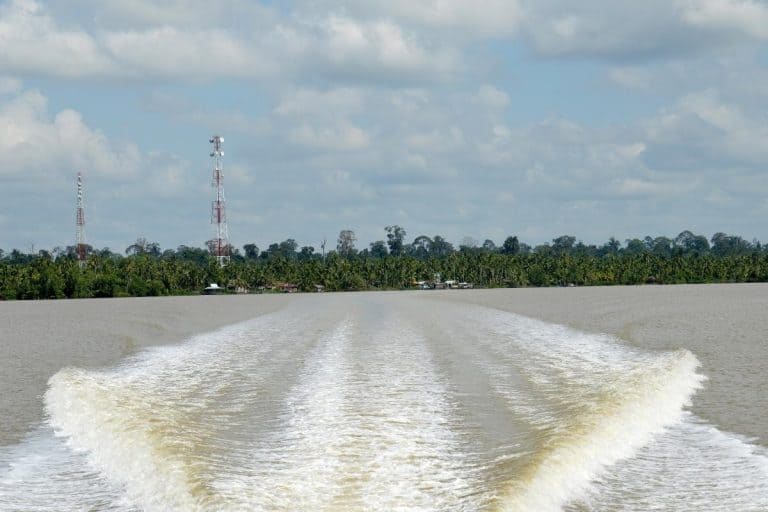
How Fast Does a Boat Need to Go to Pull a Skier? Speeds Listed for Various Boat Types
When entertaining guests on your boat by pulling them on skis, you know your boat needs to achieve…

Do Pontoon Boats Hold Their Value? You Might be Surprised
If you’re thinking of purchasing a pontoon boat, one of the questions you’ll undoubtedly have is whether this…
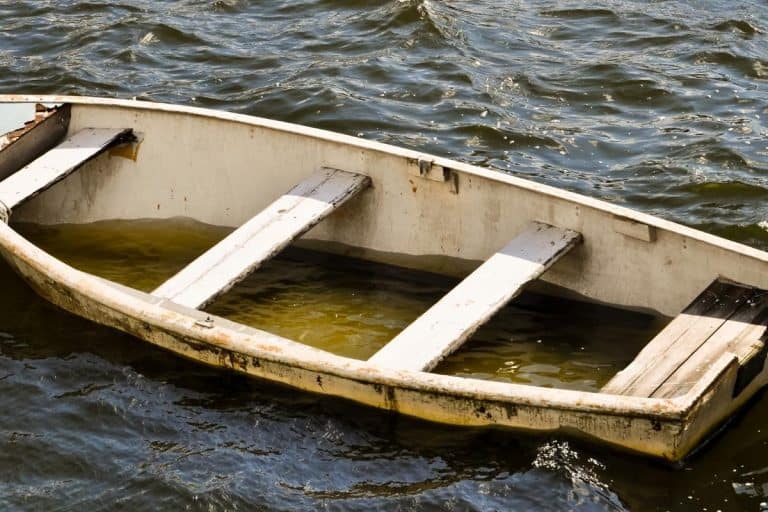
Do Jon Boats Have Drain Plugs?
A drain plug on a boat allows water to drain, but you can’t find such a plug anywhere…
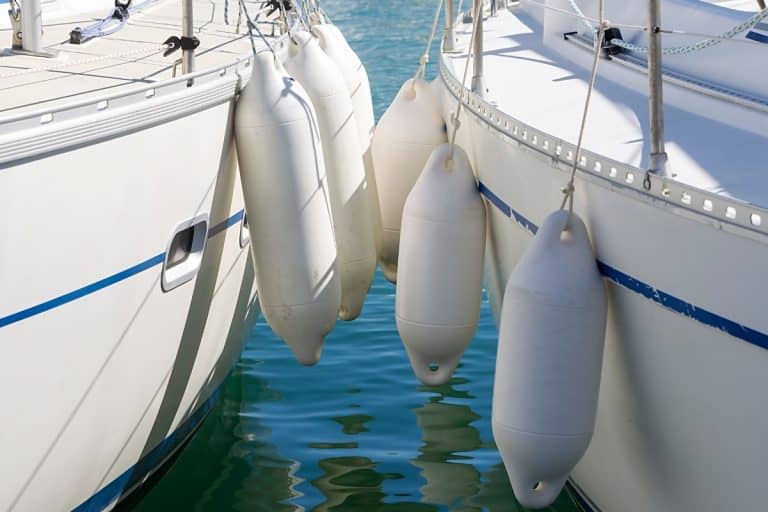
Boat Fenders And Boat Bumpers: Why Your Boat Needs Both!
Boat fenders and boat bumpers often get lumped in together, which can convince some boaters that they’re the…
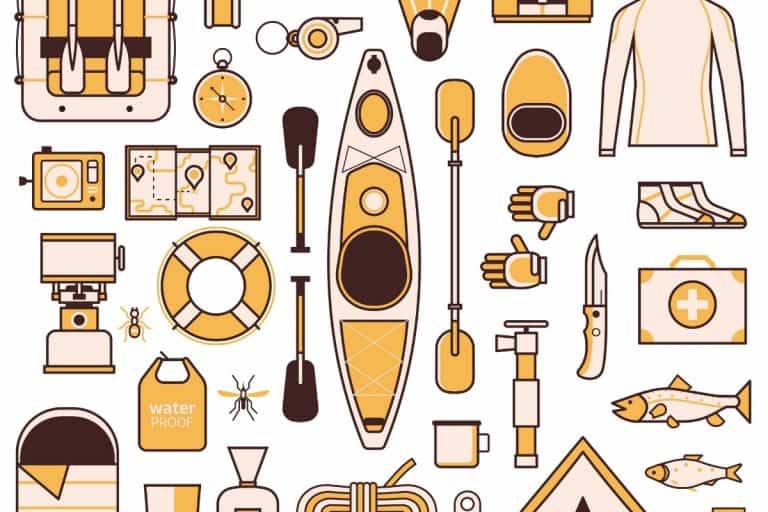
15 Best Gifts for New Boat Owners
Do you have a new boat owner in your life that would love a few gifts for their…

3 Ways to Make Your Inflatable Boat More Durable
Although inflatable boats are usually more affordable than other boat types, you still don’t want yours to prematurely…

Service Locator
- Angler Endorsement
- Boat Towing Coverage
- Mechanical Breakdown
- Insurance Requirements in Mexico
- Agreed Hull Value
- Actual Cash Value
- Liability Only
- Insurance Payment Options
- Claims Information
- Towing Service Agreement
- Membership Plans
- Boat Show Tickets
- BoatUS Boats For Sale
- Membership Payment Options
- Consumer Affairs
- Boat Documentation Requirements
- Installation Instructions
- Shipping & Handling Information
- Contact Boat Lettering
- End User Agreement
- Frequently Asked Questions
- Vessel Documentation
- BoatUS Foundation
- Government Affairs
- Powercruisers
- Buying & Selling Advice
- Maintenance
- Tow Vehicles
- Make & Create
- Makeovers & Refitting
- Accessories
- Electronics
- Skills, Tips, Tools
- Spring Preparation
- Winterization
- Boaters’ Rights
- Environment & Clean Water
- Boat Safety
- Navigational Hazards
- Personal Safety
- Batteries & Onboard Power
- Motors, Engines, Propulsion
- Best Day on the Water
- Books & Movies
- Communication & Etiquette
- Contests & Sweepstakes
- Colleges & Tech Schools
- Food, Drink, Entertainment
- New To Boating
- Travel & Destinations
- Watersports
- Anchors & Anchoring
- Boat Handling
- ← Boats & Tow Vehicles
Types of Powerboats and Their Uses
Advertisement
What Is An Outboard Runabout?
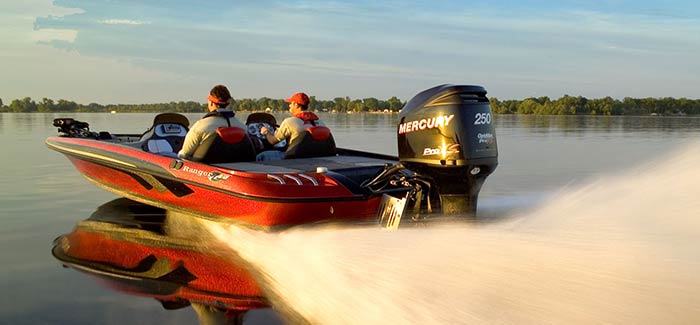
Bass boats are generally 14' to 23', and typically used for freshwater fishing. They have low freeboard and a V hull. They are specialized for bass fishing on inland lakes and rivers. Due to the special gear, high horsepower outboards and trolling motors they are a relatively high price point.
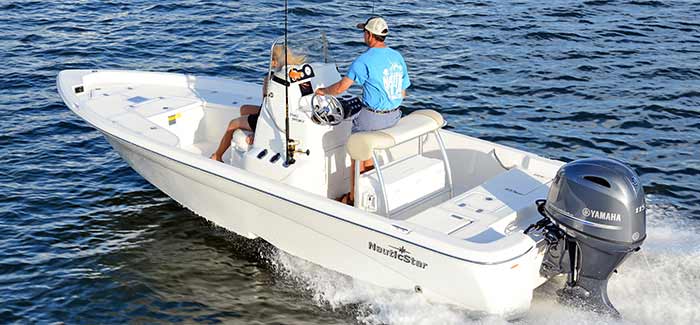
Bay boats have a low profile. They are designed for use in shallow waters of large shallow bays, estuaries or near shore. Bay boats are 18'–24' in length and are fiberglass because they are used in salt or brackish waters. They have more freeboard than a flats boat.
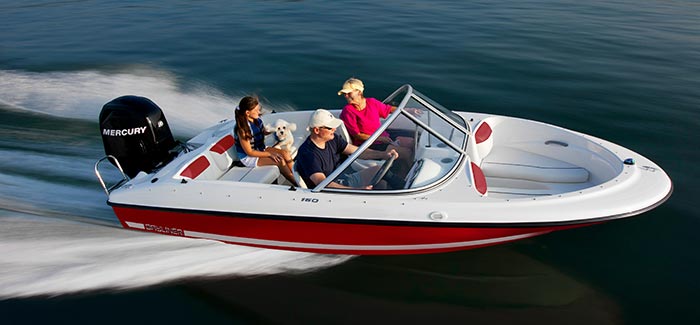
A bowrider has an open bow area designed for extra seats forward of the helm. Bowriders are usually 17'–30'. They are powered by either stern drive or outboard engines. Considered a family boat and can be used for fishing and water sports. A good choice for those new to boating.
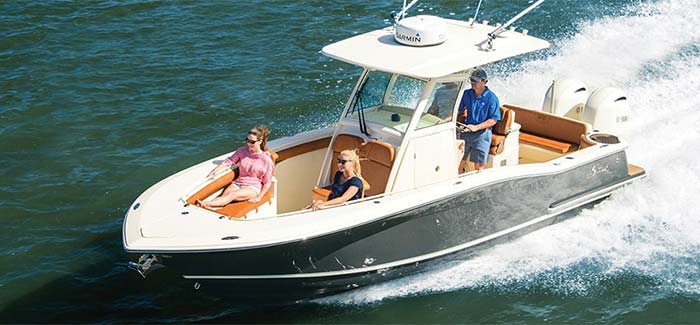
Center Console
Center console boats are from 13'–45'. They are so-named because their helm is on a console in the center of the boat. Like walkarounds, the open hull helps anglers walk from bow to stern without having to navigate around the console. Most use outboard motors for propulsion and the larger size boats are suited for offshore fishing.
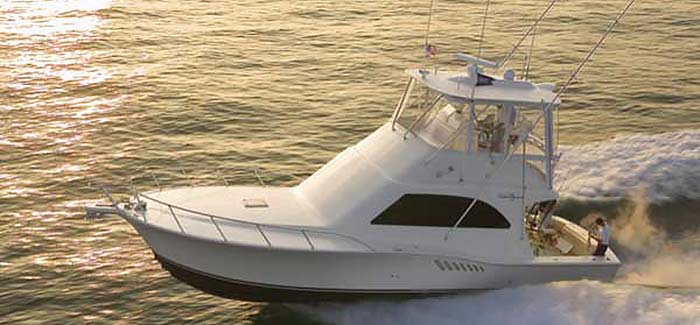
Convertible Fishing Boat
Convertibles are 35 foot and greater boats suited for offshore fishing and cruising. They have large cabins, galleys and berths and are perfect for pleasure cruises and offshore fishing. The flybridge with elevated helm helps to spot flotsam or fish. They have a large fishing deck aft.
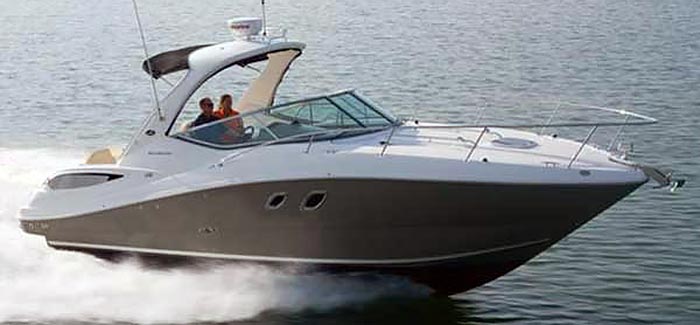
Cruisers are from 21'–45' in length and have a cabin in the bow of the boat. Cruiser cabins are designed for an overnight stay and are typically large enough for a small galley, several berths and an enclosed head.
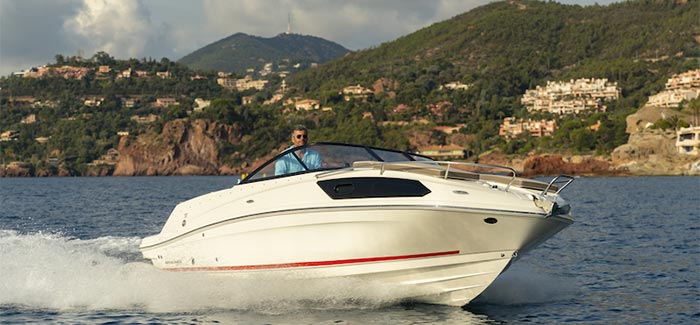
Cuddy Cabin
Cuddy cabin boats have a small cabin for storage or a small seating area. They may accommodate a berth and or head. They are usually about 22–30 feet in length.
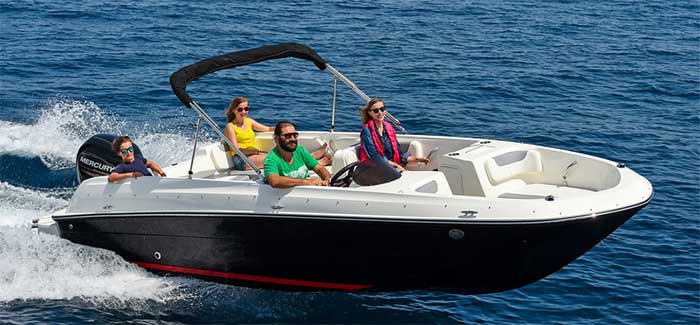
Deck boats have a wide beam and feature a V-shaped hull which offers more performance than a pontoon boat. Featuring an open deck with plenty of seating for parties or family. Used for swimming and water sports. They are outboard or stern drive powered and can be aluminum or fiberglass. These boat are about 25–35 feet long.
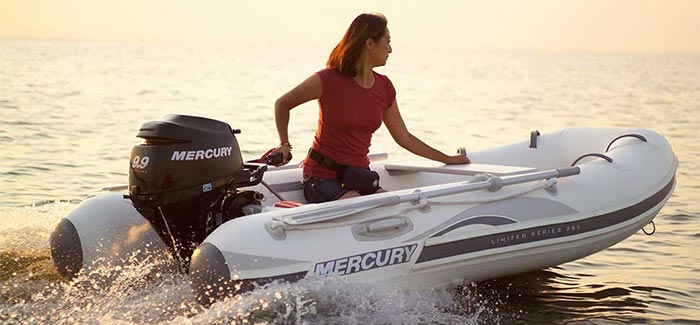
A dinghy is a small boat, usually 7–12 feet in length. They are usually powered by oars, small outboards, or sails. Often carried or towed by a larger boat for going ashore. Low cost and an excellent choice for those new to boating.
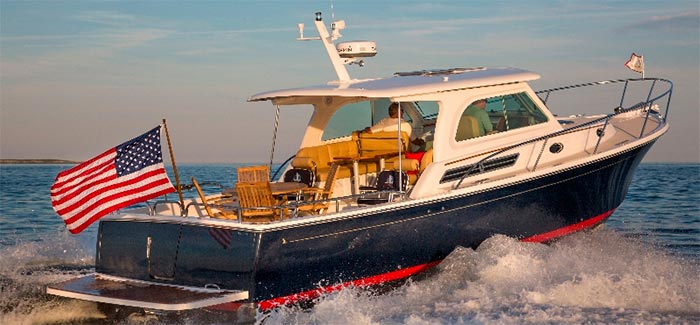
Downeast Cruiser
These boats are native to coastal New England. Also called lobster boats, they are built for offshore cruising and fishing. They have a cabin with berths and a head and dining area.
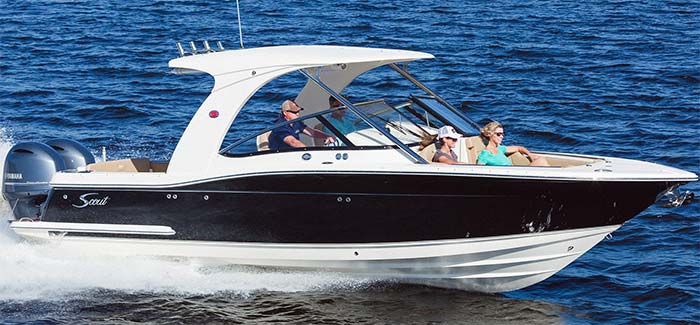
Dual Console
Dual Console boats have two dashboards and windshieldswith space to walk between them for allowing access to the bow area for seating and/or fishing. Lengths run 16–30 feet.
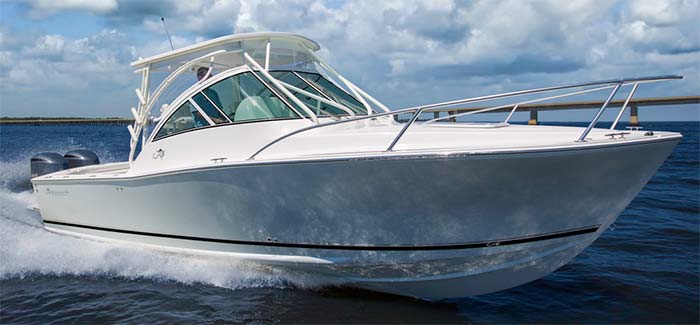
Express Fisherman
The Express Fisherman is designed for high speeds to get to offshore fishing spots in a hurry. They are rigged for offshore fishing. They have large open cockpits and fish fighting areas aft. They usually have limited cruising accommodations but can provide overnight shelter.
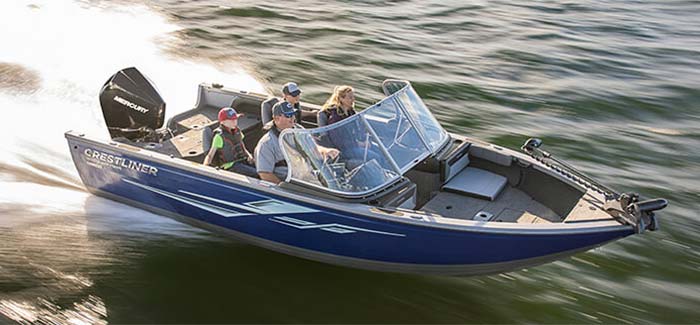
Fish 'n Ski Boat
Fish 'n Ski boats are used for fishing or skiing. These are family boats. They have accessories for each application. They feature comfortable seating and offer livewells and tie downs for rods and have removable, elevated tow bars and ski lockers. They are usually 16–24 feet in length.
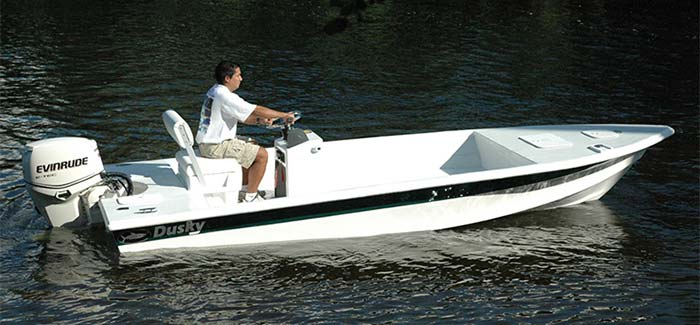
Flats Boats range from 14 feet to 18 feet and are specifically designed to navigate shallow waters needing extremely shallow drafts. A push pole is used to navigate the shallow water.
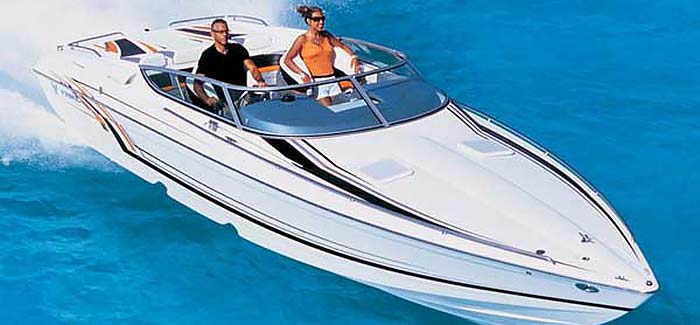
High Performance Boat
Performance powerboats are built for speed, featuring narrow beam, steep deadrise, and high power to weight ratios. They have Spartan cabins. Cockpits seat 2–6 passengers. Powered by high horsepower outboards, stern drives or surface drives, these boats are carefully designed to be fast, light and strong, ideal for racing or fast cruising. They range from 25–60 feet in length.
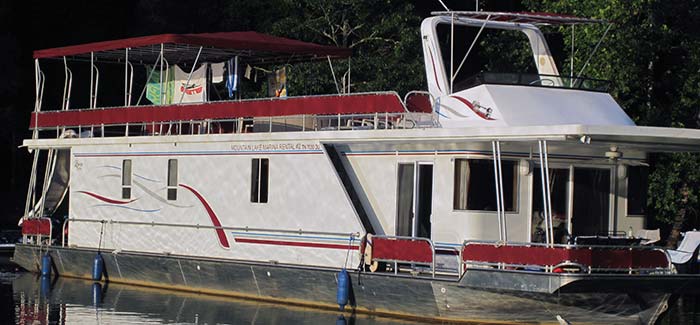
As the name implies houseboats are floating houses. They are either outboard or inboard propelled and range from 25 to 150 feet in length. Just like a house they have full kitchens, bedrooms and living and dining areas. They are the ultimate family boat. They are generally found on quieter bodies of water since they have low freeboards and are built on a barge-like hull.
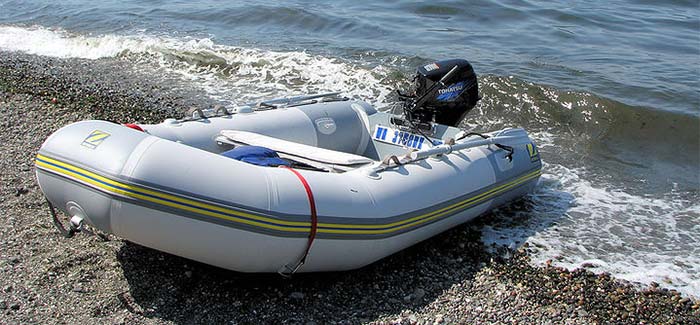
Inflatable Boat
Usually 6'–14' in length and have inflatable tubes for their sides. The floor is flexible or made rigid using plywood or aluminum floorboards depending on the size. Outboard motors can be used on the rigid transom. They deflate and are easy to transport or store. Used as dinghies on larger boats. A good choice for those new to boating.
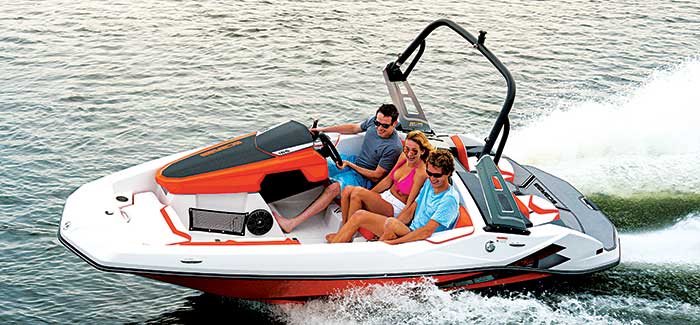
Jet Boats have single or multiple jet drives instead of a propeller for propulsion. They are very maneuverable. These smaller boats (14–24 feet) are generally used for water sports and getting into shallow waters.
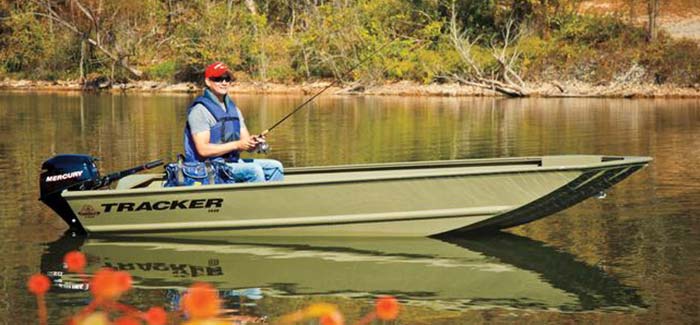
Jon boats are small utility craft primarily used for boating in shallow water. They range from 10 to 18 feet in length. They can be made of aluminum or fiberglass. They are inexpensive and a good choice for the novice boater.
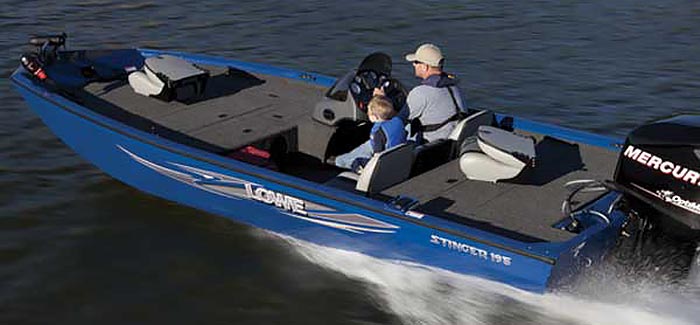
Multi-species Boat
Multi-species boats are 17–23 feet in length. They are made of fiberglass or aluminum. They are designed to travel in rougher water than bass boats. As the name implies, these boats are made for fishing a variety of different fish in all types of water.
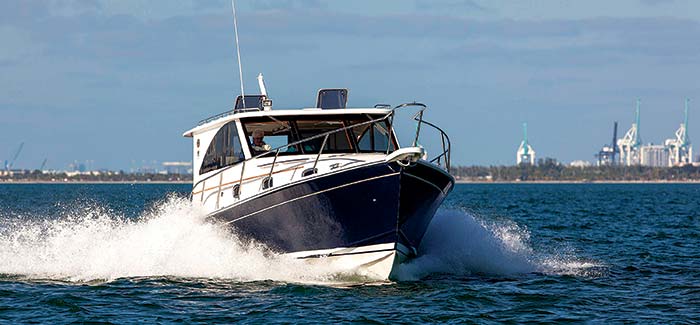
Pilothouse Boat
Featuring a fully enclosed pilot house, these boats are built to ride rougher seas while keeping helmsman high and dry. They are powered by outboards, stern drives or inboards. They are popular for cruising and many types of fishing. They usually have a berth and a head. They are usually 20–35 feet in length.
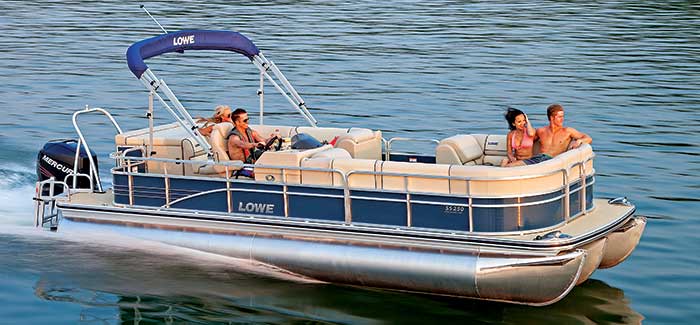
Pontoon Boat
Pontoon boats have 2 or 3 aluminum tubes that support a broad platform. They have shallow drafts and are very stable. They are usually found on inland lakes and rivers and other small bodies of water. Used for cruising, fishing and water sports. Powered by an outboard or stern-drive. Lengths from 15–30 feet.
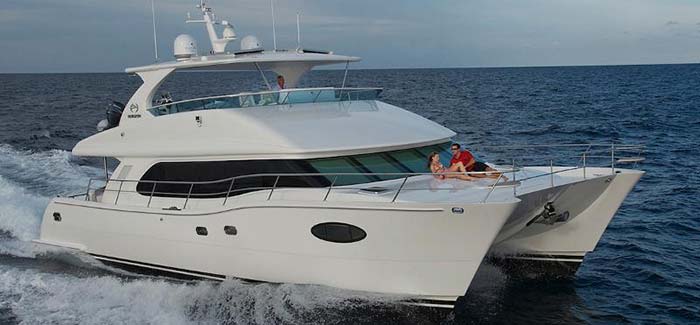
Power Catamaran
These dual-hull boats are generally used for offshore fishing. They are more rugged, provide a more stable ride, faster speeds and better fuel economy than mono-hulls. They are 25–40 feet in length.
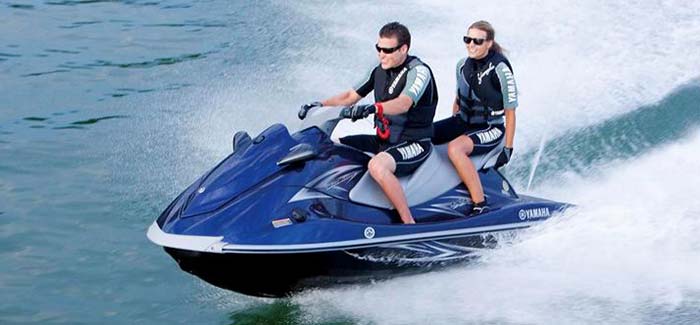
PWC (Personal Watercraft)
Entry level boats that are fun to drive and economical to buy. They come in lengths from 9–14 feet. They are usually built for 1 or 2 people but larger, more powerful models can seat up to 4. They are powered by jet drive.
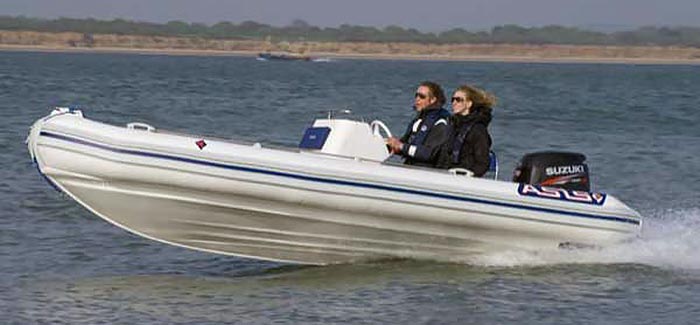
Rigid Inflatable
RIBs (rigid inflatable boat)s have a fiberglass or aluminum hull attached to inflatable outer tubes. Outboard motors are used on the transom for power. RIBs are usually faster, larger, and can carry more weight than flexible floored inflatables. They also come in larger sizes.
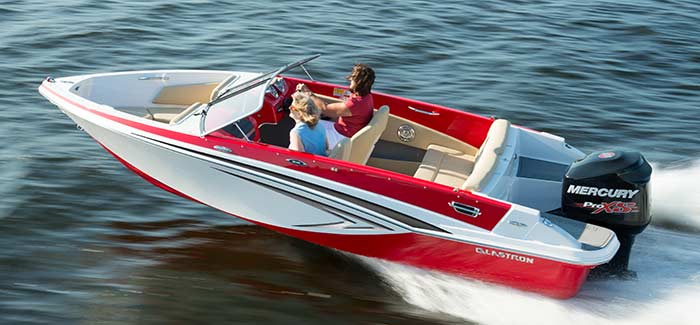
Many boats are called runabouts. Generally a runabout is defined as a small powerboat somewhere in the 14–24 foot range. They are usually powered by an outboard or stern-drive engine. They are a multipurpose boat suitable for water sports, cruising and fishing.
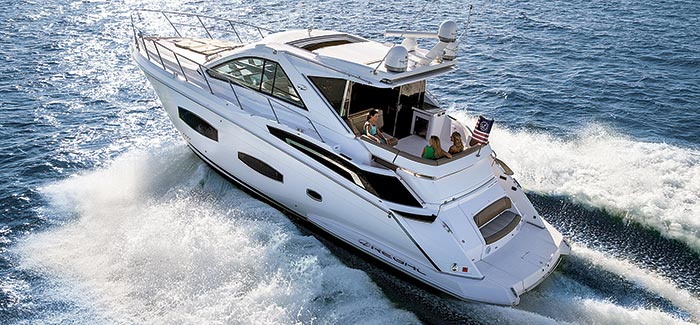
Sedan Bridge Boat
Intended for extended cruising with accommodations down below to suit long stays on the water. They range from about 35–65 feet. The bridge positions the helmsman high above the water allowing for great visibility.
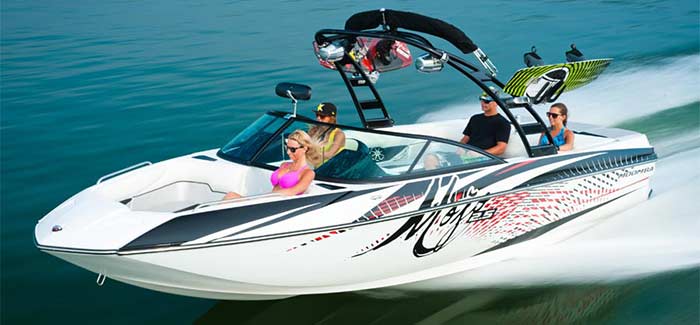
Ski and Wakeboard Boat
These boats are designed specifically for water sports. They can be ballasted for producing higher wakes for trick skiing and waterboarding. They are also great for pulling inflatable tubes.
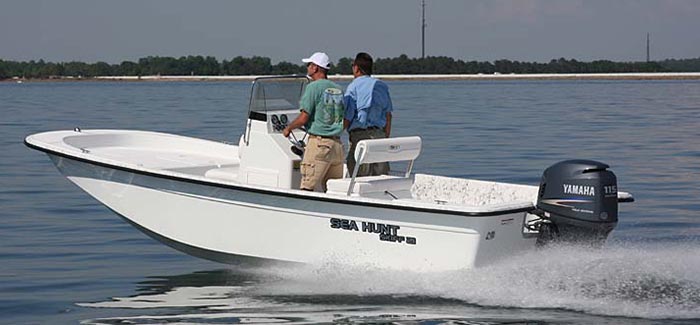
The skiff is similar to a Jon boat. They are another entry level boat. They are especially good for boating in shallow water. The can have flat or cathedral shaped hulls. Many have a console to steer from.
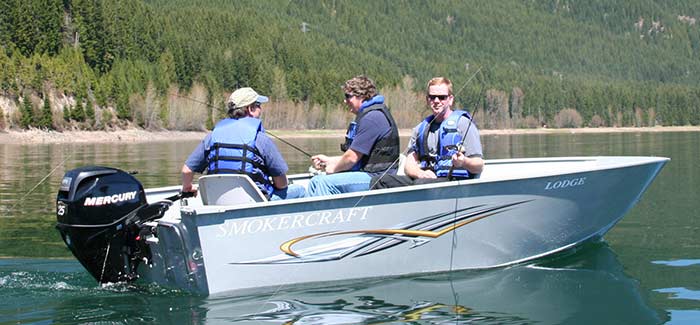
Utility Boat
Utility boats are made for tough use. Generally made of aluminum with outboard power and range from 12–20 feet. Used for fishing or as workboats. Relatively low cost to maintain and a good choice for the novice boater.
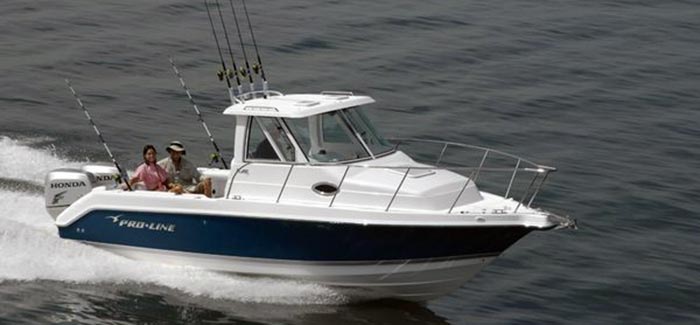
Walkarounds
Walkarounds allow an angler to walk around the cabin. They are generally 20–30 feet in length. They are usually found on larger bodies of water and can be powered by an outboard, Inboard/outboard or inboard engine.
Related Articles
The truth about ceramic coatings for boats.
Our editor investigates the marketing claims of consumer-grade ceramic coatings.
Fine-Tune Your Side Scan Fishfinder
Take your side-scanning fishfinder off auto mode, and you’ll be spotting your prey from afar in no time
DIY Boat Foam Decking
Closed-cell foam flooring helps make boating more comfortable. Here’s how to install it on your vessel
Click to explore related articles
BoatUS Editors
Contributor, BoatUS Magazine
Award-winning BoatUS Magazine is the official publication of Boat Owners Association of The United States. The magazine provides boating skills, DIY maintenance, safety, news and more from top experts.
BoatUS Magazine Is A Benefit Of BoatUS Membership
Membership Benefits Include:
Subscription to the print version of BoatUS Magazine
4% back on purchases from West Marine stores or online at WestMarine.com
Discounts on fuel, transient slips, repairs and more at over 1,200 businesses
Deals on cruises, charters, car rentals, hotel stays and more…
All for only $25/year!
We use cookies to enhance your visit to our website and to improve your experience. By continuing to use our website, you’re agreeing to our cookie policy.
- Paddle Board

A Complete Guide to Personal Watercraft (PWC): All You Need to Know!
Are you looking for some fun out on the lake this weekend? A personal watercraft (PWC) offers you plenty of power, performance, and loads of fun. The “jet ski” and “wave runner” gained popularity over the last 20-years, with mass adoptions for sports and recreational use.
PWCs offer your crossover use for fishing and watersports, with dozens of custom configurations for use in saltwater and freshwater conditions. Whether you’re using a PWC to tow into the wave of your life at Teahupoo or taking it out on the lake for some fishing, it’s a convenient, easily transported vessel that is suitable for short-term use and day trips in all water conditions.
The PWC is so popular that they now account for more than a third of annual watercraft sales. According to estimates, there are over a million PWCs in service today, with more models selling around the world every hour of the day.
When PWCs launched, manufacturers started with a standing model, known as the “jet ski.” This PWC carries a single passenger, and it’s a dynamic, highly maneuverable watercraft. The craft had few accessories and features, but it offered plenty of fun for water sports enthusiasts.
Shortly after that, the seated version of the PWC arrived, named the “wave runner.” These models are like the motorbikes of the ocean, featuring a longer length than the jet ski and more seating capacity, accommodating up to four passengers on the seat.
The wave runner comes with more storage under the seat and in the bow of the vessel. You get plenty of power and almost the same level of maneuverability as the jet ski . While the jet ski and the wave runner are very different craft, most people refer to both models as “jet skis” or “skis.”

What Is a Personal Watercraft?
A personal watercraft is a Class A inboard motor vessel, as nominated by the Coast Guard. Therefore it must adhere to the same regulations as other motorized vessels in the Class A category. As a result, all PWCs must carry an onboard fire extinguisher and a sounding device like a horn.
The craft is subject to USCG manufacturing standards and load capacities, found in the owner’s manual and the capacity plate on the vessel. All PWCs must register with state authorities and adhere to Nautical Rules when out on the water.
While the PWC has the technical classification of a boat, there are several differences between these crafts and your average fishing or watersports vessel. Manufacturers don’t recommend using PWCs at night, and they don’t feature any lighting system.

Most states also require the driver and passenger to wear personal flotation devices or life vests when operating the craft. Some local authorities also prohibit the use of PWCs in lakes and marine reserves, so check with your authorities before taking it out onto the water. Some states may also place time limits on using the craft, such as between 9 am to 5 pm during the day.
Some states also require adults to accompany minors driving the craft, and some states might even require you to complete a license test to use the PWC legally.
The primary features and functions of the PWC are maneuverability in the water. These crafts operate using jet propulsion engines and no external propellors. The motor sucks the water up from the hull, pushing it through an impeller that forces the water into a jet, expelling it from the rear of the craft to provide thrust.
The mobility of the craft allows them to make tight turns on a dime, with a tiny turning circle and powerful acceleration. They are suitable for use in lakes and estuaries and the largest surf conditions. The PWC relies on thrust for turning, so the driver must constantly engage the throttle when turning to power the boat out of turns.
Most models come with a throttle key attached to a lanyard that cuts the power to the engine if the rider falls from the PWC.
The PWC offers you excellent use for fishing and watersports. They have the power and speed to tow wakeboards, and the low-profile hull means they can reach the shallowest waters for fishing in the flats.

Benefits of Personal Watercraft
The PWC comes with plenty of benefits for day fishing trips and watersports. Here are some of the top benefits of owning a PWC.
Speed and Handling
The speed and handling of the PWC are unlike any other watercraft available. The throttle-based steering system means you can make the sharpest turns.
Some drivers develop amazing techniques for 180-degree turns at high speed, dipping the front of the boat into the water while hitting the throttle and turning the handlebars, resulting in a hairpin tun that’s electrifying to watch and even more thrilling to do yourself.
They have plenty of speed, and the motorbike-style setup means that you feel the speedway more than you do in a power cruiser or speedboat.
Trailerable
The PWC offers you easy transport from your home to the water. Most models come with a trailer included with your purchase. They are exceptionally easy to launch and trailer, requiring just two people for the job.
Fishing and Watersports Capabilities
The PWC is ideal for fishing and watersports. The seated models allow up to four people to sit on the craft and deep, wide footwells on the sides. The vessel is stable, and you can stand up without misbalancing the vehicle.
The power of the motor makes it possible to tow skiers and wakeboarders with ease. Most models include tow bar hitches on the rear of the craft for the attachment of ski ropes . The low profile of the hull makes it exceptionally easy to reach shallow waters.

Efficient Jet Motors
The PWC relies on efficient jet propulsion motors for powering the craft. The motor capacity can vary between models, with some engines having capacities up to 1,498cc, producing 310-HP from a four-stroke motor. The jet propulsion system is more efficient than an outboard motor, giving you plenty of range with the craft.
Multiple Sizing Options
You have options for single-person standing models and for boats that can seat anything up to five or six people, depending on the length. Most wave runners measure under 8-feet in length.
Affordable Price Tags
The PWC comes with a remarkably affordable price tag, and that’s why it’s such a popular watercraft. Entry-level models cost around $5,000, while the high-end models with customizations cost up to $20,000. That makes them one of the most affordable high-performance watercraft available.

Disadvantages of Personal Watercraft
The personal watercraft is a highly functional, high-performance boat for fishing , watersports, or just having fun out on the water. However, they do come with a few drawbacks compared to other fishing and performance boats .
Limited Standing Room
While the side of the vessel has a deep gulley for your feet, there is practically no room to move around on the ski.
Limited Storage
Most models come with under-seat storage for the full tank and battery and a few accessories for your trip. The primary storage area is in the bow, holding your fire extinguisher and a tow rope or snack and drinks for the day.
No Bow Access
The PWC doesn’t have any bow access for standing or casting. You have to do everything from your seat.
Limited Seating
Most models cater for two or three people, with some of the largest designs catering for up to five passengers. However, you’re not going to get the same passenger capacity as other traditional watercraft.
Not Suitable for Long Trips
The PWC is suitable for day trips. They have a decent range, but they are not ideal for long trips. As mentioned, the manufacturer does not intend the PWC to function for nighttime use.
No Amenities
The PWC doesn’t include any amenities like a head, sink, or accommodation.
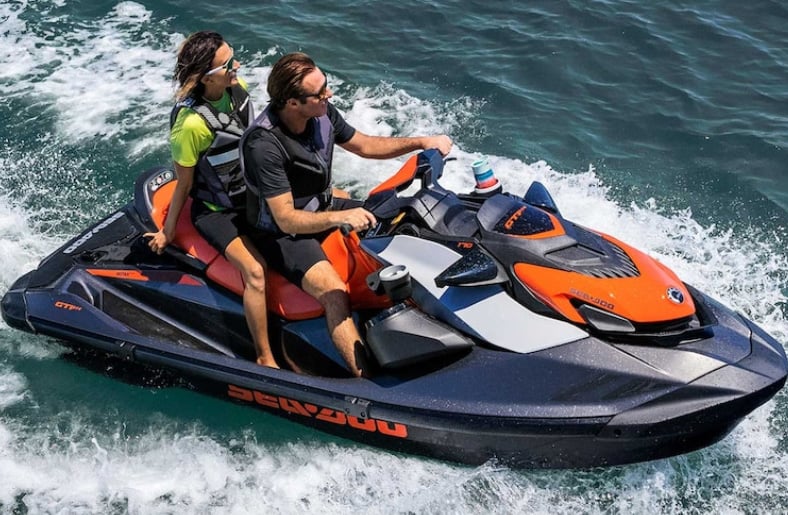
Best Personal Watercraft Brands and Models
There are dozens of brands offering PWCs, and plenty of models in each manufacturer’s range. Here are our top choices for the best PWCs available.
Kawasaki Jet Ski SX-R
Kawasaki has one of the best reputations for PWC manufacturers. This brand built its reputation on building high-performance motorbikes, and it transferred this technology into its PWC range. As a result, you get an extremely fast and agile boat with plenty of power and performance on tap.

The Kawasaki Jet Ski SX-R is an affordable boat, costing around $10,000, depending on the customizations you want for the vessel. This model is a single-person craft in the jet ski style, with a driver set up that lifts you from the deck.
You get a powerful 1,498cc four-stroke engine allowing the rider to cut through the water at speeds up to 60-mph. The Kawasaki Jet Ski SX-R weighs 551-lbs with an 8′ 8.5″ length. You get exceptional handling and plenty of power for competitive racing or use offshore in big wave conditions.
Yamaha WaveRunner EX
Yamaha is another popular motorbike brand offering you a range of PWC designs. This model is the Waverunner style, giving you a seat accommodating up to three riders.
There are several model options at different price points, with the entry-level model being the EX retailing for $6,999 EX, the EX Sport for $7,999, the Deluxe $8,999, the EXR Race $9,499, and the flagship of the range, the Limited, retailing for $9,599.

You get a 1,049cc Yamaha TR-1 four-stroke motor offering you a top speed of 50-mph on flat water, a fuel capacity of 13.2 gallons, and a 7.7-gallon storage capacity.
This Yamaha model is a great choice for fishing or watersports, offering you exceptional performance in all water conditions.
Sea-Doo Spark
If you’re looking for the most affordable, high-quality PWC, we recommend going with the Sea-Doo Spark . This PWC has a price tag of $5,499, making it one of the most affordable high-performance models available on the market.
You have options for a two-seater base model, or you can upgrade to the more accommodative three-seater option for an extra $1,700. This model comes with a 7.9-gallon fuel capacity. You get a 352-lbs capacity for the 2-seater model and a 540-lbs capacity for the three-seater model.

The primary difference between the Sea-Doo Spark and other PWCs is the molded Polytec hull, giving the boat a strong hull featuring design and construction with polypropylene materials reinforced with fiberglass.
As a result, you get a lighter model than those using a molded fiberglass hull, allowing for the use of smaller motors to power the craft. The Sea-Doo Spark comes with an efficient but powerful 899cc Rotax 900 ACE engine producing 60-HP. You can expect a top-end speed of over 40-mph on flat water.
If you want a faster, more powerful model, you have an option to upgrade to the 90-HP version for an extra $1,300 on the price tag – well worth the extra money. The Trixx versions of the Sea-Doo Spark 2021 come with a variable trim system (VTS), allowing you to control the bow-rise at speed, and you get step wedges angled behind the seat.
As a result of the intelligent ergonomic design of the craft, you can ride the Trixx model in a standing position, almost vertical to the surface of the water. You also have the option of riding it in the seated position.
The Trixx comes with a powerful 90-HP Rotax motor, and you have custom options for Sea-Doo’s iBR electronic reversing system, custom graphics, and telescopic handlebars for easy rider height adjustment.
Wrapping Up
The PWC offers you a versatile, affordable watercraft that’s ideal for watersports and fishing. While there might be some limitations on passenger and storage capacities, it’s a fun craft to take out on the water for fishing, skiing, or just cruising the rivers.
With average price tags that are a fraction of a powerboat, it’s a great entry-level watercraft for anyone that wants to get out on the water.

John is an experienced journalist and veteran boater. He heads up the content team at BoatingBeast and aims to share his many years experience of the marine world with our readers.
A Complete Guide to Micro Skiffs: All You Need to Know!
A complete guide to narrow boats: all you need to know, a guide to aluminum fishing boats.
Comments are closed.
Type above and press Enter to search. Press Esc to cancel.
- Pontoon Boats
- Personal Watercraft
- nauticalknowhow
- Nautical Knots
- Tools and Calculators
The Complete Guide to Personal Watercraft
A Personal Watercraft (PWC) is a small vessel which is designed to be operated by a person sitting, standing or kneeling on it. The US Coast Guard defines it as an inboard boat and it uses a water jet pump as the primary source of motive power.
A PWC is not a toy despite the fun that you can have with one. If you operate a PWC, you have the responsibility of knowing and obeying boating regulations and practicing boating safety. Personal watercraft are subject to the same rules and requirements as any other powerboat plus additional requirements specific to PWCs
PWC Regulations
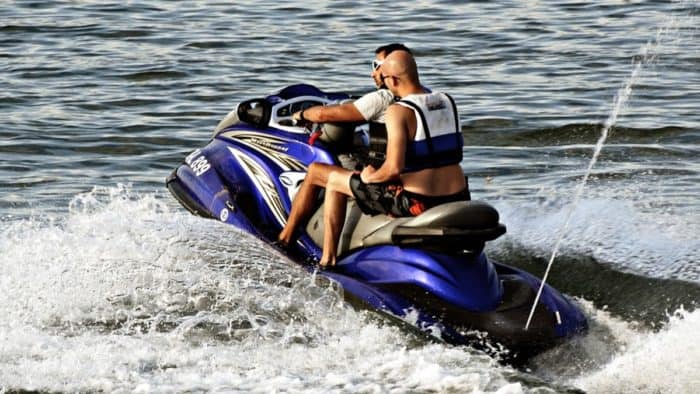
In addition to the general regulations in effect for motorboats PWC owners must also be aware that there are local laws and ordinances around the country that further restrict PWC operations. They include:
- Age of the operator
- Hours of operation
- Special no wake zone provisions
- Assigned operating areas and restrictions
- Speed and distance limits.
Make certain you know the laws that apply to you in your area of operation. For example, some states prohibit wake jumping or require no-wake speed when within 100 feet of the shoreline. Because PWCs are not equipped with navigation lights, operation is prohibited at night and during times of restricted visibility.
Federal Regulations for All Personal Watercraft:
- be registered and display a registration number in accordance with state and federal guidelines.
- have properly fitted, CG approved personal flotation devices (life jackets) for each person on board (In most states they are required to be WORN by a PWC operator or passenger.)
- PFDs should have an impact rating equal to, or better than, the PWC maximum speed
- have a CG approved, Class B-1 fire extinguisher aboard the PWC
- have a lanyard connected to the start/stop switch if your PWC is equipped with such a switch. This will stop the engine if the operator falls off.
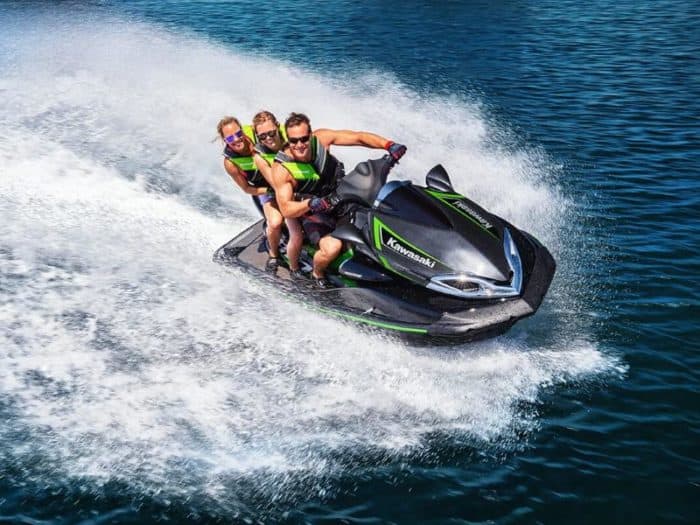
- Never start your engine without attaching the lanyard to your wrist or PFD. If you fall off, the engine automatically stops running so your craft will not travel a great distance and you can easily swim to it. It will prevent the PWC from running unattended in areas populated by swimmers or other watercraft.
- The Personal Watercraft Industry Association (PWIA) also recommends that the operator wear eye protection, a wetsuit, footwear, and gloves.
How Your PWC Operates
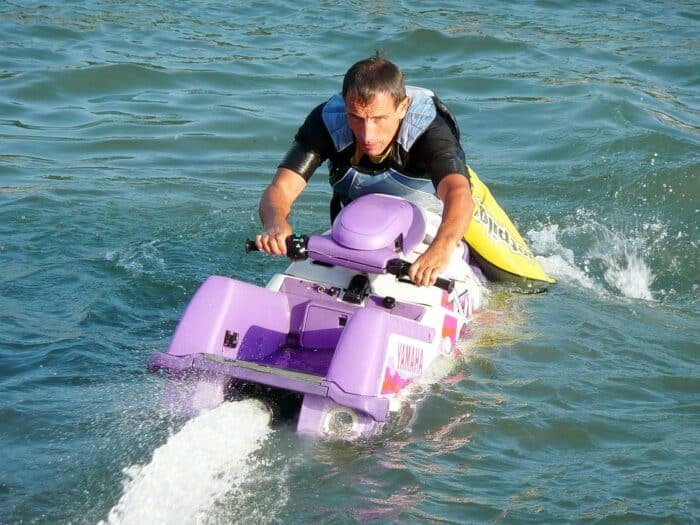
PWC operators need to keep in mind that a jet drive requires moving water through the drive nozzle for maneuverability.
- You must have power applied in order to maintain steering control .
- If you release the throttle to idle or if the engine shuts off during operation you will lose all steering control.
- In either situation, the PWC will continue in the direction it was headed before the throttle was released or the engine was shut-off. Operation of the steering control will have no effect.
- If you are approaching a dock, shore, or other vessel at a speed greater than you can control and you release the throttle to idle or shut off the engine, you will have no maneuvering capability and the PWC will continue its forward movement.
Newer PWCs have a reverse mechanism that you can use to slow the forward motion of the vessel.
- These PWCs are equipped with cowlings that allow them to operate in reverse.
- The reverse cowling is a specially designed diverter that can be lowered over the jet nozzle.
- The water jet produced by the jet nozzle hits the reverse cowling and is directed back toward the front of the PWC, thus producing a force that propels the PWC backward.
- Although this feature is convenient for low speed operations in close quarters, it can be quite dangerous if used in situations for which it was not designed.
- Operating in reverse can greatly reduce the ability to steer. Using the reverse feature at other than idle speed can throw the operator forward, and perhaps off, the PWC.
- In addition, using reverse at high speed can raise the stern of the PWC, pushing the bow down and under water. If your PWC has this feature you should use it with caution only after you have tested its capabilities and limitations at low speed in open water.
Stability and Steering
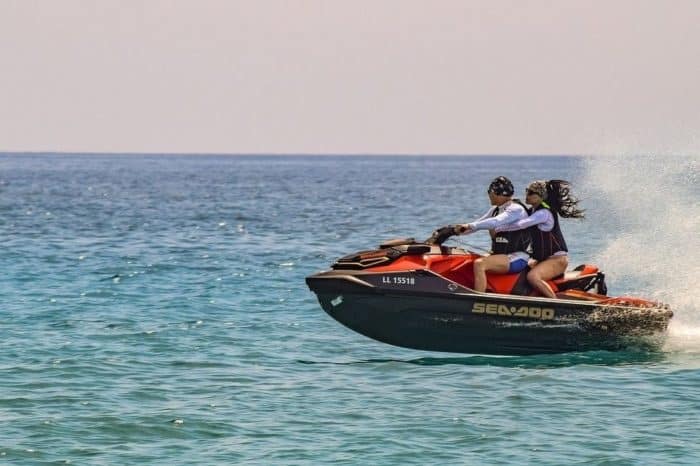
PWCs are less stable when idle and gain stability as you gain speed. Think of it like a motorcycle or bicycle that is harder to balance if you’re not moving.
- The force of the water being propelled under the PWC and out the back adds some support to the hull during movement.
- Because typical PWC utilize mechanical steering devices and directional jet nozzles to turn their craft, their center of gravity and pivot point are far forward and this can create an abrupt tail sliding instability problem.
- Do not exceed the manufacturer’s recommended load capacities
Tips for Operating a PWC
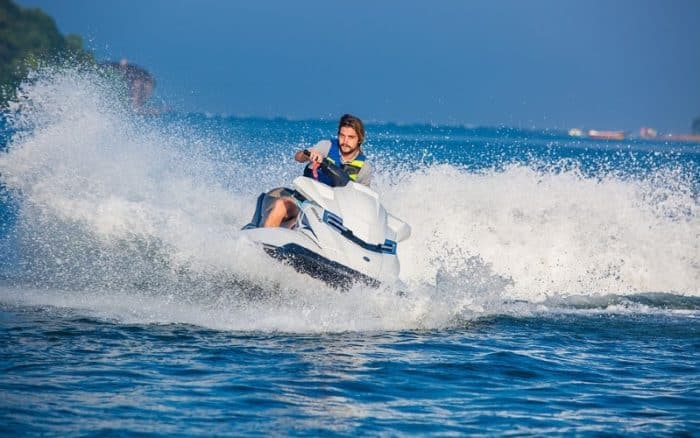
Most PWC accidents occur from running into another object, most often, another PWC. Operating in a crowded our congested area requires special precautions. Look at what other boats around you are doing
- Always look around and behind you before making a turn.
- Remember that you must obey all rules of operation as they apply to motorboats.
- Larger boats may not even be able to see you if you are too close and may not be able to get out of your way in time.
Re-boarding
Should you fall off your PWC don’t abandon it. If it has not righted itself, turn it over. Most PWCs carry a label that shows how to do this. If yours does not, check your owner’s manual.
- Approach the PWC from the stern and pull your self up onto your knees on the boarding platform.
- From there continue to pull yourself back up on the seat.
- Be sure to attach the kill switch lanyard to the kill switch and to your body or PFD.
- Start up and get back underway.
You should practice reboarding prior to operating the PWC to make sure you are able to do it alone. Remember, a PWC is less stable when idle in the water.
Reserve Fuel Tank
PWCs are equipped with reserve fuel tanks that can be switched to if you run out of fuel. With proper planning you should never have to use your reserve tank. Always plan your outing according to the 1/3 rule to avoid running out of fuel.
- Use 1/3 of your fuel going out
- 1/3 coming back
- 1/3 in reserve
- Do not count the reserve tank in this 1/3
Common Issues and Complaints About PWCs
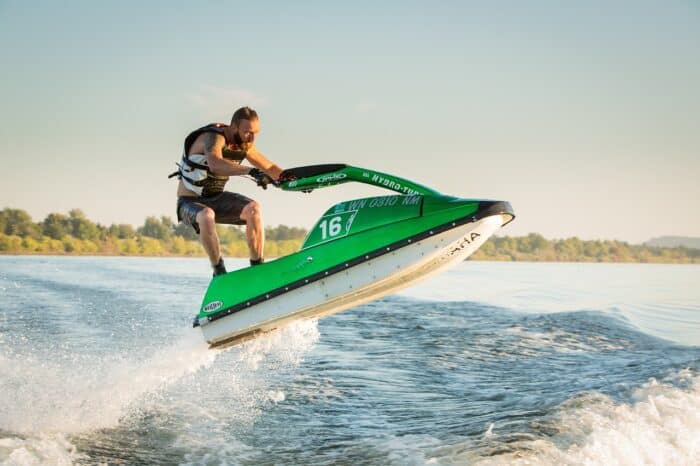
Most complaints to law enforcement officials regarding the operation of PWCs fall into the following categories. Avoid these breaches of common courtesy and consideration.
- Wake jumping: This is not only irritating to boaters attempting to be watchful and maneuver in heavily congested areas, but it is extremely dangerous. In one case, a wake-jumper in Florida got tangled up in the props of a cabin cruiser and was killed.
- No wake zones: If you want to get on the wrong side of a responsible boater, disobey no wake zones. You are likely to find yourself with a ticket, since most boaters and shoreline property owners will not hesitate to report violators of slow-no-wake areas.
- High speeds too near shore or other boats: Most states require 100-200 feet of separation between boats and the shore when moving at more than no-wake speeds. (No wake means the slowest possible speed your boat will go and still provide maneuverability.)
- Noise: Excessive noise near shore or near anchored boats is sure to draw negative attention. Be considerate of property owners and other boaters.
Environmental Concerns About PWCs
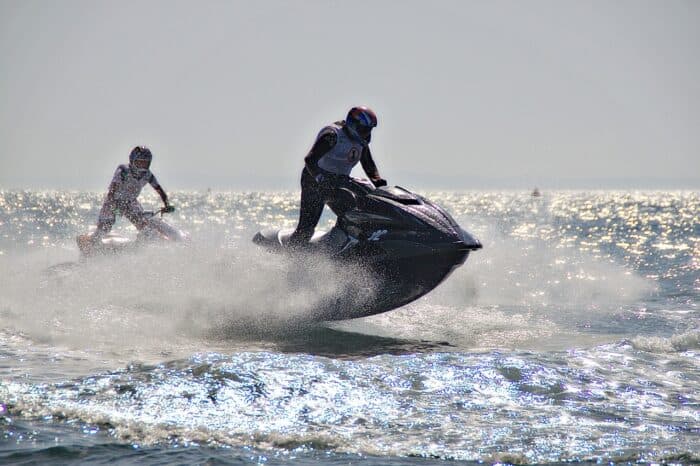
- Pollution: Refuel on land to reduce chances of spillage into the water. Don’t overfill your fuel tank. Check and clean your engine well away from shorelines.
- Turbidity: In shallow waters where PWCs can easily operate, the bottom gets stirred up, suspending sediment which cuts down on light penetration and depletes oxygen. This can affect bird and fish feeding. To avoid this, operate your PWC in deeper water. If you do have to traverse shallow water, run at idle speed.
- Vegetation: In coastal areas be aware of low tide. Low water levels expose sea grass beds and other delicate vegetation. Disturbances can cause erosion and long lasting damage. As a side effect, ingesting seaweed and seagrass is not good for your engine. Feed it clean water and it will run and maneuver much better.
- Wildlife harassment: A PWC near shore can interrupt feeding and nesting wildlife, and cause animals to deviate from their normal behavior. And that, by law, is illegal. Mammals such as otters, manatees, and whales can be injured by direct contact with a boat, and it is believed that the noise from watercraft can even adversely influence breeding cycles and cause birth defects. So avoid areas of high animal populations.
Remember, our waterways belong to everybody! If all boaters act responsibly and courteously, obey the rules, and protect the environment, our seas, lakes and rivers will provide all of us a lifetime of enjoyment and recreation.
The Bottom Line
As fun as a PWC is, they need to be treated more like cars than toys. They can be dangerous if not used properly. You should always understand how it works before you get on. You also need to know the laws and regulations that apply where you’re going to be boating. You can still have plenty of fun with a pWC while being responsible at the same time.
About Chris
Outdoors, I’m in my element, especially in the water. I know the importance of being geared up for anything. I do the deep digital dive, researching gear, boats and knowhow and love keeping my readership at the helm of their passions.
Categories : nauticalknowhow
Leave a Reply Cancel reply
Your email address will not be published. Required fields are marked *
Save my name, email, and website in this browser for the next time I comment.
More in nauticalknowhow

How to Tie a Boat to a Dock

How to Clean a Boat Cover

Everything You Need to Know About Your Boat’s Bilge Pump

4 Ways to Tie Your Boat Shoes

The People’s Poncho Review and Ratings

Oru Lake Kayak Review

What Is A Gunwale?

131 of the Best Hawaiian Boat Names

167 Patriotic Boat Names
About boatsafe.
Established in 1998, BoatSafe is your independent guide into the world of boating, fishing, and watersports. We provide expert insights and detailed guides to help you find products tailored to your needs and budget.
Contact Boatsafe
- Address: 4021 West Walnut Street. Rogers, AR 72756
- Phone: (479)339-4795
- Email: [email protected]
Site Navigation
- How We Test
- Corrections Policy
- Privacy Policy
- Terms & Conditions
- Editorial Policy
- Affiliate Disclosure
Our Reviews

All content is © Copyright 2024. All rights reserved.
- Motorcycles
- Car of the Month
- Destinations
- Men’s Fashion
- Watch Collector
- Art & Collectibles
- Vacation Homes
- Celebrity Homes
- New Construction
- Home Design
- Electronics
- Fine Dining
- Costa Palmas
- L’Atelier
- Les Marquables de Martell
- Reynolds Lake Oconee
- Scott Dunn Travel
- Wilson Audio
- 672 Wine Club
- Sports & Leisure
- Health & Wellness
- Best of the Best
- The Ultimate Gift Guide
The 11 Best Personal Watercraft for Fun and Play on the High Seas
This group shows how much water bikes have changed in the last 50 years. here are our favorites across eleven categories., jeff hemmel, jeff hemmel's most recent stories.
- ‘Flying’ Surfboards Have Never Been More Popular. Here Are the 7 Best eFoils on the Market.
- Share This Article

Personal watercraft may have started out as wet-and-wild toys for grown-ups (hey, that’s not a bad thing!), with the first “water scooters” appearing in Europe in the 1950s. The first official standup, the Kawasaki JS 400 Jet Ski, appeared 50 years ago and sold more than 200,000 units. More than a decade later, the first sit-down jet bikes hit the market, thanks to Bombardier Sea-Doo and Yamaha WaveRunner, and started a craze that lasted into the late 1990s, when over 200,000 units were sold each year. While annual unit sales have dropped to about half that, the modern fleet has grown increasingly diversified.
The standup personal watercraft is still available from Yamaha and Kawasaki, as well as a handful of custom builders, but sit-down models dominate the market. These range from barebone two-seaters to more luxurious three-seat models to customized fishing models to electric watercraft to hybrid personal watercraft/inflatables that are priced at half a million dollars.
Thrill-seekers will still find an abundance of craft to satisfy that need for speed, but so too will adventure and camping enthusiasts, hard-core anglers, electric-power enthusiasts, and family buyers.
Here are our favorites across 11 categories.
Best Luxury: Kawasaki Jet Ski Ultra 310LX

If you want bells and whistles from a mainstream player, Kawasaki’s Jet Ski Ultra 310LX reigns supreme. Its deep-V hull and supercharged 310hp engine have won championships in tough offshore conditions. Drive-control and auto-trim functions tweak power delivery and holeshot. Electronic reverse makes for intuitive low-speed handling while providing stopping power at speed. It’s the extras, however, that put it over the top. Standards include a 200-watt, four-speaker Bluetooth sound system, backup camera, and eye-catching LED running lights. $21,199
Best Family: Yamaha FX Limited SVHO

The bottom line for family buyers? They want a craft that’s comfortable, safe, and stable in a variety of water conditions, and reliable enough to count on every time they venture out. Yamaha’s FX Limited SVHO has all that in spades, as well as a long list of standards. They include a color touchscreen display, Garmin GPS/Fishfinder, Bluetooth sound system, and GPS mapping with geofencing capability to reign in young riders. Limited-package extras add an inflatable tube, towrope, and inflator, as well as often-purchased items like a custom cover, soft-sided cooler, fenders, and storage organizers. $20,399
Best High-Performance: Sea-Doo RXP-X 325

Boasting 325 hp, Sea-Doo’s RXP-X 325 is the current Top Gun in the personal watercraft market. Created by some substantial tweaking of the existing Rotax 1630 ACE engine, the craft rockets to 60 mph in 3.4 seconds. Top speed flirts with 70 mph. Cool features include a movable backrest to lock riders into the controls, a carbon-fiber hood, and a hydraulic steering damper that can be adjusted to eliminate unwanted feedback through the handlebars in rough conditions. $19,199
Best Standup Tie: Kawasaki Jet Ski SX-R 160 and Yamaha SuperJet

Is it a copout to call this one a tie? We don’t think so. Kawasaki’s SX-R and Yamaha’s SuperJet both feature powerful four-stroke engines, and boast strong acceleration and nimble handling. Their looks and personalities, however, definitely divide buyers. The Kawasaki is sexy-sleek with stylish graphics. The Yamaha is chunky at the bow, and will definitely benefit from some aftermarket graphics. The real decision will likely come down to riding style. Buy the heavier Kawi if you want to powerfully carve up slalom courses, real or imagined. Go for the lighter Yamaha if you prefer a craft that’s a tad more playful and want to jump a few wakes. Yamaha $10,699; Kawasaki $11,999
Best Motorbike-Style: Searider Searacer

Yamaha’s WaveBlaster was once considered the closest thing to a motorbike on the water, and while it still boasts a legion of hardcore fans, the craft hasn’t been produced for nearly three decades. Searider’s Searacer just may step in to fill the void. Recently unveiled at boot Dusseldorf , the electric-powered, superbike-influenced design features a pivoting front ski for directional control and dual electric-motor powertrain. Weighing in at only 143 pounds, the Searacer promises top speeds of 48 mph and up to 50 minutes of ride time per charge. $30,325
Best Camping/Adventure: Sea-Doo Explorer Pro 170

Sea-Doo created an entire “adventure” category to target those who like to explore, camp, and push their riding beyond the norm. The Explorer Pro 170 is built to be fuel-efficient, haul an impressive amount of gear, and shelter its occupants. The latter is achieved by a front windscreen. As to the gear, Sea-Doo’s spacious front storage is complemented by an extended aft deck featuring pop-up cleats that anchor coolers, storage containers, or additional fuel caddies. Pick a direction on the Garmin GPS, load up the supplies, and camping equipment and head for the horizon. $18,899
Best Electric: Taiga Orca Performance

Taiga Motors Orca Performance delivers a ride that is without emissions, smell and, other than the whirr of the driveshaft, almost without noise. A 120 kW electric motor produces the equivalent of 160 hp, pushing the Orca to 62 mph in “Wild” mode. As with all electric vehicles, it’s better to tame things down and stretch the runtime to two hours before recharging. Standard household current will bring a depleted battery back to full charge in 14-20 hours. Level 2 charging can shorten that number to 3.5 hours or at Level 3, it’s just a brief 30 to 40 minutes. $19,490
Best Freestyle: Rise Icon

Kawasaki and Yamaha may have stepped away from lightweight, freestyle-oriented standups, but brands like Rise have taken things to the next level for riders who want to slash ocean waves or pull off backflips and spins. The Icon boasts an advantageous horsepower-to-weight ratio thanks to a 701cc Yamaha engine outfitted with plenty of aftermarket upgrades combined with a sleek, lightweight hull and deck. Added features include aluminum-tube handlepoles that bring riders closer to the boat’s pivot point, pivoting thrust nozzles that help send the bow skyward, and plenty of padding and footholds to stay locked in. Starting at $25,280

Best Hybrid: T3MP3ST Maverick GT Ski + Jet RIB

Custom built to satisfy the truly discerning buyer, T3MP3ST’s Maverick GT boasts carbon-fiber construction, a 550hp electric motor and a broad variety of material and color choices, making it one of the most unique personal watercraft on the water. Alone, the Maverick GT was originally conceived as a tow-in vehicle for big-wave surfers at massive breaks like its namesake Mavericks. But dock the craft into its the Maverick Tender (a 30’ RIB) and it takes on a bigger presence, expanding the craft’s possibilities for up to eight passengers. $500,000
Best Fishing: Sea-Doo Fish Pro Trophy

Other manufacturers have embraced fishing, but Sea-Doo’s Fish Pro Trophy remains the best catch. Based on Sea-Doo’s GTX platform, it’s stable at both rest and trolling speeds and more than ready for offshore conditions. It’s the boat’s standards, however, that reel in anglers. Standouts include a touchscreen Garmin fishfinder, 13.5-gallon cooler/livewell, debris-free pump system, trolling-specific speed control mode, and a clever tweak that creates an elevated fishing chair. Think the “trophy” moniker is overkill? YouTuber Emmanuel Williams recently caught a swordfish off this very boat. $20,499
Best Foiler: Valo Hyperfoil

Foils are suddenly the rage in America’s Cup racing and SailGP, not to mention on powerboats like the Navier 30 and Candela C-8 . The technology is also what makes the Valo Hyperfoil different than anything on the water. California start-up Boundary Layer Technologies defines its jet bike–like vehicle as a high-performance electric hydrofoiling craft with wings to fly above the water. That barely begins to describe the R&D that went into making this fuel-efficient craft work. The Valo has three elements that retract. There’s an electric motor at the stern and two foiling wings designed for a coordinated deployment. BLT says the Skyride system measures the position of the craft 100 times per second, modifying the flaps on the wings and other leading edges. All this technology isn’t cheap. The Valo Hyperfoil is priced at $59,000, with a reservation of $500 required to secure a production slot.
Read More On:
More marine.

This New 239-Foot Megayacht Concept Pairs Sleek, Minimalist Design With Over-the-Top Luxury

Numarine Just Delivered 3 New Explorer Yachts at Once

This New 220-Foot Hybrid Megayacht Uses State-of-the-Art Heat Recovery to Save Energy

This New 62-Foot Solar-Electric Catamaran Is Topped by a Luxe Skylounge

Culinary Masters 2024
MAY 17 - 19 Join us for extraordinary meals from the nation’s brightest culinary minds.
Give the Gift of Luxury
Latest Galleries in Marine

Day One Superyacht in Photos

12 Fascinating Facts About ‘Kismet,’ the 400-Foot Megayacht With an Underwater Lounge
More from our brands, mschf duplicates picasso’s ‘le poisson’ as part of first l.a. exhibition ‘art 2’, 3 sportsbooks say south carolina-iowa was most-bet women’s event, how to watch ‘wwe raw’ online for free, paris again considers resurrecting richard serra sculpture from storage, the best medicine balls, according to fitness trainers.
- New Inventory
- Pre-Owned Inventory
- Outboard Engines
- Value Your Trade
- Service & Parts
- Fiberglass Repair
- All Locations – Map
- Lake Texoma
- Oklahoma City, OK
- Keystone Lake
- Branson, MO
- Paradise Cove Hulbert, OK
- News and Events
- Feedback and Reviews
Personal Watercraft – A Beginner’s Guide to Choosing
Introduction.
Imagine the thrill of speeding through the water, wind whipping through your hair, the sun reflecting off the rippling waves. That’s the exhilarating experience of riding a personal watercraft (PWC). Whether you are an outdoor enthusiast, a water sports lover, or just someone looking for a new adventure, owning a personal watercraft can open up a whole new world of fun and excitement. However, choosing the right PWC can be quite a task, especially for a beginner. There are a plethora of options available, each with its own unique features, capabilities, and price points. This comprehensive guide aims to provide you with the necessary information and insights to make an informed decision when purchasing your first PWC. From understanding what a PWC is and its different types, to factors to consider when choosing one, and even tips on maintenance and insurance, we’ve got you covered. So, let’s dive in and start your journey to finding the perfect personal watercraft for your needs.

Understanding Personal Watercraft (PWC)
What is a personal watercraft (pwc).
A Personal Watercraft (PWC) is a type of vessel that appeals to thrill-seekers who crave a boating experience that puts them close to the water. They are compact, nimble, and powered by a water jet, providing an experience akin to riding a motorcycle on water. The affordability and easy maintenance of PWCs make them an attractive choice for those who are new to boating or looking for a secondary boat for a fresh kind of fun.
Different Types of PWCs: Jet Skis, WaveRunners, and Sea-Doos
When it comes to PWCs, the marketplace offers diverse options, each offering unique advantages catered to your desired ride experience. These are often referred to by their brand names such as Jet Skis, WaveRunners, or Sea-Doos.
Jet Skis is a term that originates from the brand name of personal watercraft manufactured by Kawasaki. There are various models available, including stand-up and three-passenger models, and even supercharged ones for those seeking extra power.
WaveRunners refer to the brand of PWCs from Yamaha . They offer four distinct series composed of 18 different models. These models are well-regarded in the industry, with several receiving Watercraft of the Year awards.
Sea-Doos are another popular brand of PWCs . Their lineup includes six different models, some of which have received notable design awards.
Beyond brand names, PWCs can also be categorized based on the rider’s position, the number of passengers, and the type of water conditions they’re designed for. For instance, stand-up PWCs cater to single riders and are often used for active pursuits like tricks and racing. On the other hand, sit-down PWCs are designed for a more comfortable ride and can accommodate multiple riders, making them suitable for family outings or towing objects like rafts or wakeboarders.
Uses of PWCs: From Family Fun to Emergency Services
The versatility of PWCs extends to their wide range of uses. Whether you’re a beginner learning the ropes, a family looking for fun on the water, or an adrenaline junkie seeking action and adventure, there’s a PWC model designed for you. Their compact size makes them perfect for navigating narrow channels and shallow waters, making them a popular choice for fishing enthusiasts. PWCs also serve in emergency rescue services, where their speed and maneuverability prove invaluable for quick rescues. Even law enforcement officials use PWCs to patrol waterways and respond to on-water incidents.
Whichever type of PWC you choose, the most important thing is to select one that aligns with your needs and preferences. So, take your time, do your research, and get ready to make waves with your very own personal watercraft.

Factors to Consider When Choosing a PWC
Choosing the right personal watercraft (PWC) is a crucial decision that requires careful consideration of multiple factors. By understanding your individual needs and preferences, you can ensure that your PWC offers the best possible experience on the water.
Determining Your Needs: Passenger Capacity and Towing Capability
Just like every boat enthusiast has unique tastes, each PWC can cater to a variety of needs. One of the first things you should consider when choosing a PWC is the passenger capacity – will you be riding solo, or do you anticipate bringing friends or family along for the ride? Smaller models are typically more agile, perfect for the lone rider with a need for speed. On the other hand, larger models can accommodate up to four passengers and often offer better stability, making them ideal for families or groups.
If you’re interested in water sports, you’ll also need to consider a PWC’s towing capability. Do you dream of wakeboarding or tubing behind your PWC? Then you’ll need a model with enough horsepower to tow a raft or wakeboarder.
Freshwater vs. Saltwater: Where Will You Ride?
Another vital consideration is where you plan to use your PWC. Lakes, rivers, oceans, and canals all offer unique riding experiences, but they can also impact the longevity and performance of your PWC. For instance, saltwater can cause quicker corrosion, so if you plan to ride in the ocean, you may want to consider a PWC with a closed-loop cooling system to prevent saltwater from entering the engine.
New vs. Used: Pros and Cons
Deciding between a new or used PWC is another critical decision. New PWCs often come with warranties and the latest improvements in performance and technology. However, they are also more expensive. On the flip side, used PWCs can be a more affordable option, but they may require more maintenance and lack the latest features.
Budget Considerations: Setting a Realistic Budget and Exploring Financing Options
Finally, you should have a set budget in mind before you start browsing. Remember to consider additional costs like maintenance, insurance, storage, and potential repairs. You should also factor in the cost of essential gear and accessories, such as personal flotation devices. Don’t forget that financing options may be available to help make your dream of owning a PWC a reality.
By carefully considering these factors, you’ll be well on your way to choosing a PWC that matches your lifestyle, needs, and budget. Get ready for endless fun on the water with your perfect PWC!
Comparing Different PWC Models
Once you’ve determined your needs, budget, and preferred riding environment, it’s time to delve into the different types of PWC models available on the market. From affordable Rec-Light models to sleek Performance models, there’s a PWC out there for every type of rider.
Rec-Light Models
Starting off with the most affordable options, Rec-Light models are a fantastic choice for those looking to dip their toes into the world of PWCs. These models can comfortably carry two adults or two adults and a child. They are equipped with a 60 to 100 horsepower engine and can reach top speeds of about 45 MPH. While these models may not have the power to tow a tube or boarder, they offer a smooth ride in calm waters.
Recreation Models
Next up are the Recreation models. With engine options ranging from 120 to 180 horsepower, these models offer a bit more speed and power, reaching top speeds of 50 to 60 MPH. They often come with additional features like electronic reverse control, speed control options, performance options, and optional audio systems. These models are perfect for long-range cruising or towing.
Luxury/Touring Models
For those who crave comfort and power, Luxury/Touring models are the way to go. These feature-laden models boast engines with over 300 horsepower and a top speed exceeding 65 MPH. They provide a stable ride in most water conditions and offer more storage and fuel capacity than the Recreation models.
Performance Models
Performance models are built for experienced riders looking for top-notch speed and handling. Made from special lightweight material, these models house the highest horsepower engines under the seat, reaching top speeds of almost 70 MPH. These machines are not recommended for beginners due to their power and handling requirements.
Stand-Up Models
Stand-Up models are the classic choice for those seeking an athletic and challenging ride. These models require some skill and practice to master, but the reward is a truly exhilarating experience on the water. Currently, the Kawasaki Jet Ski SX-R is the only Stand-Up model available for recreational riding.
Remember, no matter which model catches your eye, it’s essential to consider your specific needs and experience level. Whether you’re a seasoned pro or a novice rider, there’s a PWC model out there that’s just right for you.
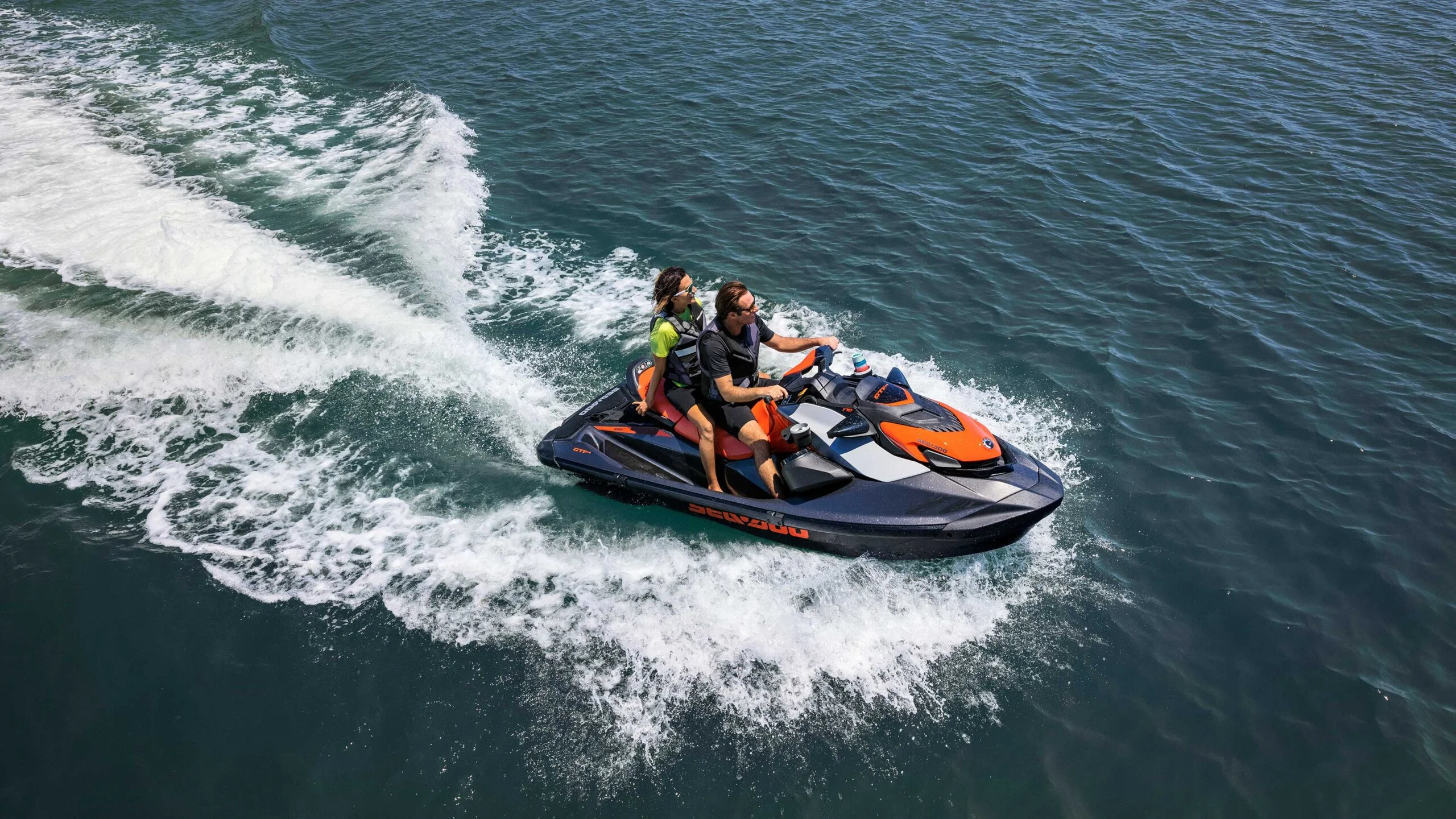
Couple enjoying a ride on their Sea-Doo GTI SE
Essential PWC Gear and Accessories
Just like the keys to a new car, owning a personal watercraft (PWC) comes with a set of essentials. But instead of an owner’s manual and a spare tire, you’ll need a collection of gear and accessories to ensure both your safety and the longevity of your PWC. Let’s break these down into two categories: safety gear and optional accessories.
Safety Gear: Life Jackets, Helmets, and More
First and foremost, safety should be your top priority when operating a PWC. This includes not only understanding the operating mechanics of your craft but also equipping yourself and any passengers with the necessary safety gear.
Life Jackets or PFDs: An accessible, wearable Personal Flotation Device (PFD) must be available for each person on board. This is not just a recommendation—it’s a legal requirement. A Type III PFD is typically worn when riding a PWC. It’s also worth noting that children under 12 must always wear their PFD on a moving vessel.
Helmets: While not a legal requirement, it’s recommended to wear a helmet when operating a PWC, especially when riding at high speeds or in choppy waters.
Engine Cut-off Lanyard: This is a safety device that cuts off the engine when the operator is thrown off the seat, preventing the PWC from continuing to move without a driver.
Sound-Signaling Device: This could be a whistle or horn. It’s a simple but critical tool for communicating with other watercraft in the vicinity, especially in an emergency situation.
Optional Accessories: Tow Ropes, Covers, and More
Beyond the basic safety gear, there are additional accessories that can enhance your PWC experience.
Tow Ropes and Skier-Down Flags: If you plan on using your PWC for water sports, you’ll need a tow rope and a skier-down flag. The flag is used to signal to other boaters that there’s a person in the water.
Covers: A sturdy PWC cover can protect your craft from the elements when not in use, extending its lifespan and maintaining its appearance.
Trailer: A trailer is essential for transporting your PWC. Even if it’s kept on the water during the riding season, you will need a trailer to transport the craft for service and off-season storage.
Neoprene Riding Gear: This includes shorts or PWC trunks and a wet suit for cold-water riding. These not only provide comfort but also protection for riders. Closed-toe boat shoes or PWC riding booties are also recommended for better traction and protection.
Remember, the right gear and accessories can make a significant difference in your PWC experience. Prioritizing safety and investing in quality accessories will ensure you and your PWC are well prepared for many seasons on the water.
Maintenance and Insurance
Whether you’re a seasoned PWC owner or a newcomer to the world of personal watercraft, understanding the maintenance requirements and insurance considerations is crucial.
Understanding Maintenance Requirements: DIY vs. Professional Services
Maintaining your PWC is a non-negotiable responsibility. Regular maintenance not only prolongs the lifespan of your PWC but also ensures a smooth and safe ride every time. Whether you opt for a new or used model, you’ll need to stick to a maintenance routine—cleaning your PWC after each ride, performing routine checks, and scheduling regular service appointments.
Depending on your mechanical aptitude, you might be able to handle some of the basic maintenance tasks yourself, such as oil and filter changes, gearcase lubricant changes, and propeller inspections. However, for more complex tasks, you should consider employing a professional marine technician. They’ll help keep your PWC in top shape by following the maintenance schedules outlined in the boat and engine owner’s manuals. Remember, poor maintenance practices can wreak havoc on your PWC, no matter how many hours it’s been used.
Insurance: State Requirements and Benefits of Separate Policies
Just as with a car, insuring your PWC is a vital part of ownership. While some homeowners’ policies may offer coverage for smaller boats and motors, they often limit or don’t cover marine-specific risks, such as salvage work, wreck removal, pollution, or environmental damage. This is why it’s often best to separate your boat insurance from your homeowner’s policy, choosing instead a coverage that caters specifically to personal watercraft.
There are two types of boat insurance policies—“agreed value” and “actual cash value.” An “agreed value” policy covers the boat based on its value when the policy was written. While this policy can cost more upfront, there is no depreciation for a total loss of the boat (some partial losses may be depreciated). On the other hand, an “actual cash value” policy costs less upfront but factors in depreciation. This policy will only pay up to the actual cash value of the boat at the time it is declared a total or partial loss.
As a PWC owner, you should seriously consider a separate PWC insurance policy as it offers plans that cover personal injuries, property damage, medical payments incurred from accidents, and damage to your PWC. It may also protect you in situations where an uninsured watercraft operator caused an accident.
In conclusion, the maintenance and insurance of your personal watercraft are not areas to overlook or skimp on. Regular upkeep and a robust insurance policy will provide peace of mind and ensure many years of enjoyable and safe watercraft use.
Making the Purchase: Working with a Dealer
The search for the perfect personal watercraft often comes down to two essential factors: the right dealer and the best deal. Let’s dive into the process of working with a dealer and closing the deal on your dream PWC.
Why Choose Blackbeard Marine: Inventory and Discounted Prices
When it comes to buying a PWC, variety is the spice of life. A dealer’s inventory can make or break your buying experience. You want a dealer who offers a wide range of models from top PWC manufacturers. This provides you with the power of choice and ensures you find a watercraft that fits your specific lifestyle and budget. Furthermore, a dealer with competitive prices can help you strike a balance between quality and affordability.
There’s nothing quite like the exhilaration of skimming over the water on your own personal watercraft. Whether you’re seeking the thrill of high-speed adventure, a fun way to spend time with family and friends, or a versatile tool for water-based tasks, a PWC can be a fantastic addition to your outdoor lifestyle.
When selecting the right PWC for your needs, remember to take your time and do your research. Consider factors such as passenger capacity, usage environment, new vs. used, and your budget. Compare different models and their features to align with your specific needs and preferences. Don’t forget the importance of safety gear, optional accessories, maintenance, and insurance.
Finally, remember that buying a PWC is an investment. Choose a trusted dealer that offers a wide selection, competitive pricing, and excellent customer service. With the right preparation and approach, you’ll soon be out on the water, enjoying the ride of your life on your very own personal watercraft.
Embrace the adventure ahead and make the most of every moment on the water. After all, life is better with a PWC!
- I Agree to receive SMS
The Ultimate Guide to Small Boats: What Are Your Options?
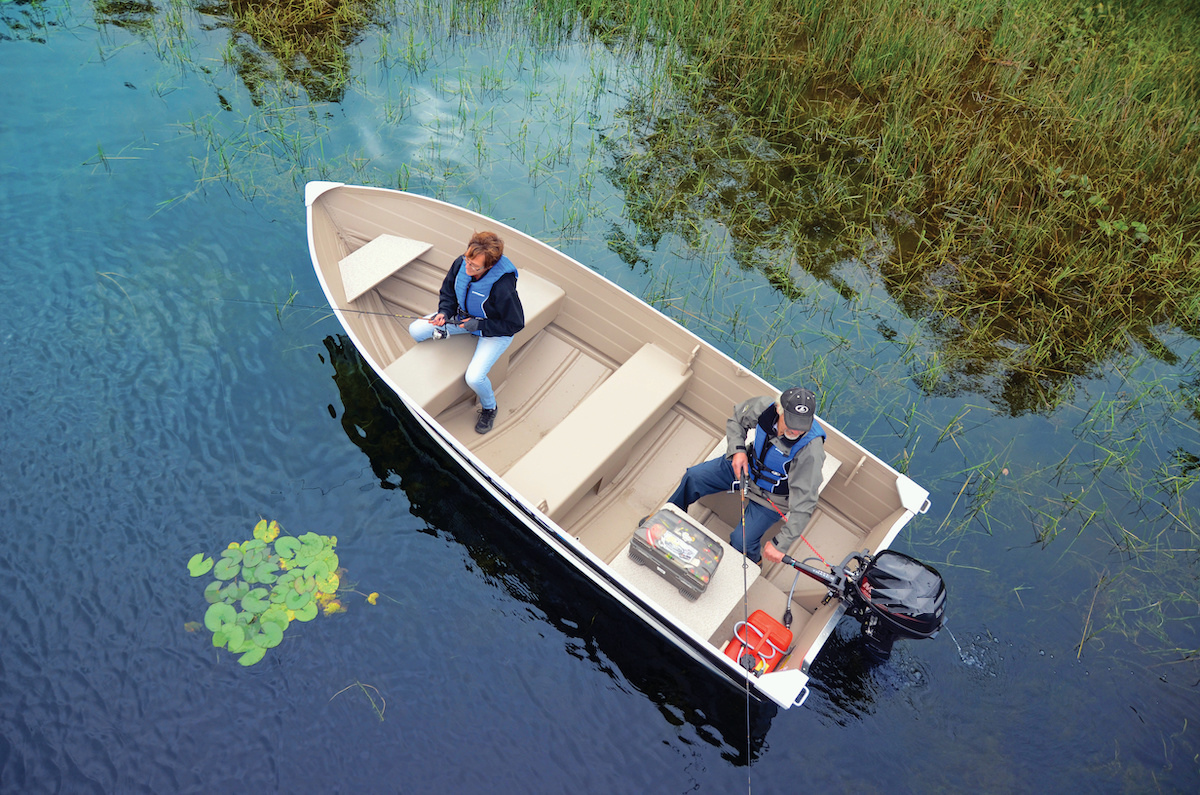
Small boats are where many people discover a love for the water, and if you’ve been browsing our Boat Finder Tool looking for small boats that would be ideal for your needs, you’ve surely encountered many options.
Small boats are less expensive to buy and operate than large ones, are easier to tow or load on a trailer, and can sneak into tiny waterways that bigger boats can’t access.
Small boats also have an esoteric value that’s difficult to pin down. There’s something special about being physically closer to the water, surrounded by nature without all the extra tools and features found on larger, more complex boats.
In fact, many boat lovers who own large boats also have a small boat or two that they love and enjoy just as much as their bigger craft. But which small boats would be best for you? To make the search easier, we'll review the top 10 small boat contenders.
Types of Small Boats
Inflatable boats, aluminum fishing boats.
- Pontoon Boats
Car-Toppers
Canoes and kayaks, personal watercrafts (pwcs).
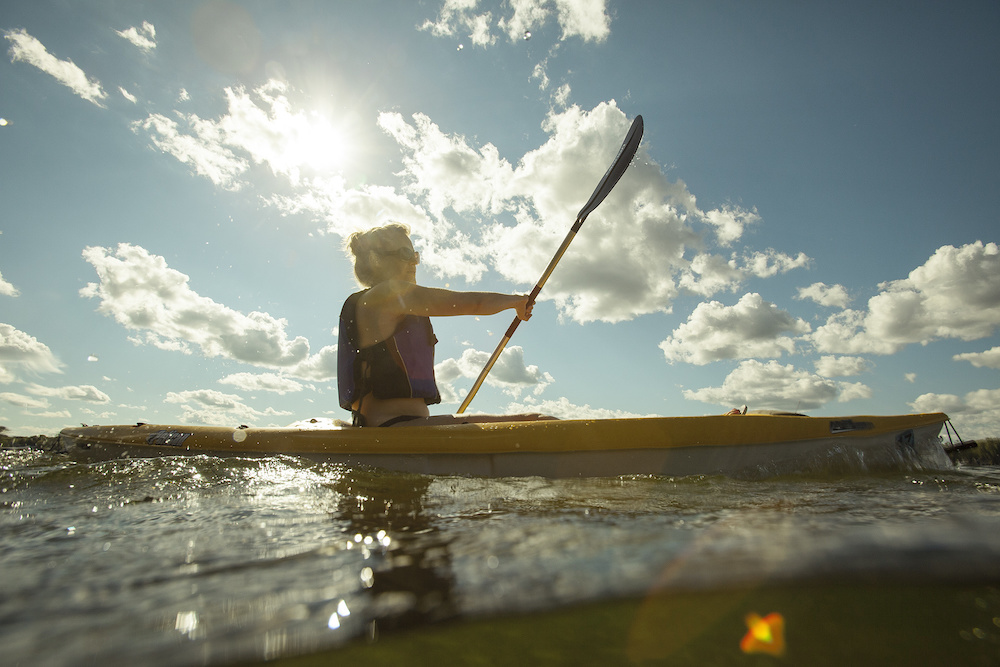
Jon Boats are among the simplest and most popular boats around. Many consist of little more than an aluminum hull with a flat bottom and a squared-off bow, bench seats, and an outboard or electric outboard engine. They’re incredibly easy to launch, load, and store and are among the least expensive options for buying a boat .
Skiffs are another form of very simple, basic, all-purpose utility boats. What exactly makes a boat a skiff? This is a catch-all term often used to describe any relatively small and open boat. Due to this, there’s an extensive range of candidates.
Dinghies come in many shapes and sizes and in different versions that can be rowed, motored, or sailed. But they all share a few common traits: they’re usually very small (eight or 10 feet is standard) and are often used as tenders to transport people and gear from a boat to shore.
Inflatable boats come in two basic styles: those that are completely inflatable and those that have a rigid hull surrounded by an inflatable “collar” or ring (usually called a “RIB,” short for rigid inflatable boat).
Most inflatables are made of materials like Hypalon or PVC fabrics. Their main advantage is the ability to bounce off anything they might hit. Still, RIB versions are also considered seaworthy and used in many commercial and search-and-rescue applications and for recreational purposes.
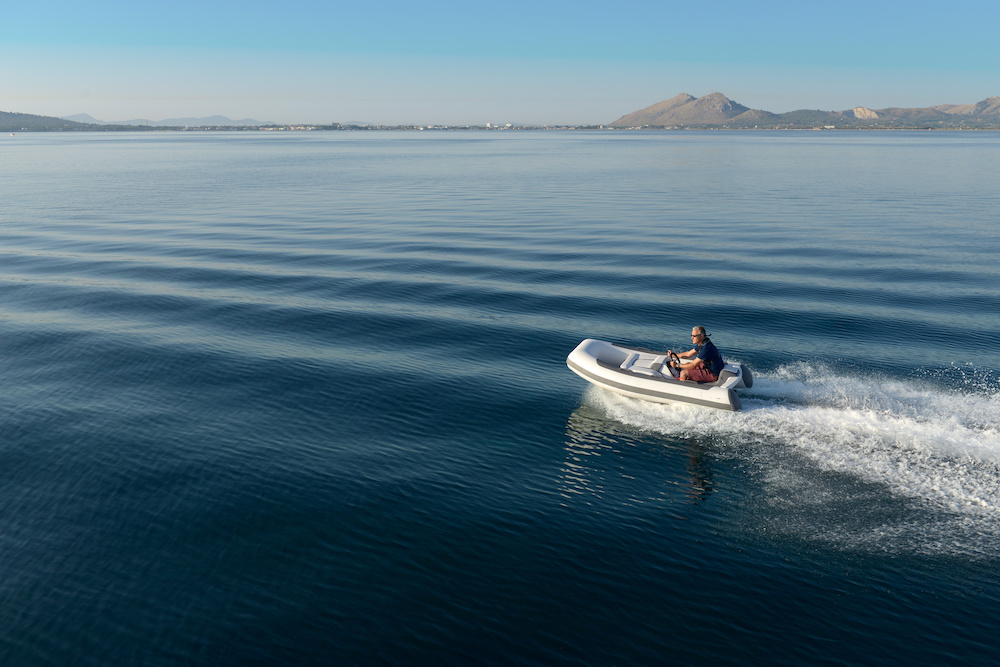
Aluminum fishing boats come in all shapes and sizes, the only common denominator being that they’re constructed of aluminum. Aluminum boats tend to be light, relatively inexpensive, and fuel-efficient.
Small Pontoon Boats
Although there are some very large and costly pontoon boats on the water, plenty of small models are available that are easy to trailer, easy to afford, and still get you a taste of luxury on the water. There are even different models and designs ranging from mini fishing pontoons to small performance pontoon boats.
Learn more in Buying a Pontoon or a Deck Boat?
This is another catch-all category of boat, with one common denominator: if a couple of people can lift it up and secure it to a roof rack on a car, the boat’s officially a car-topper. Usually, these are very small, simple boats, like Jon boats and dinghies.
These small crafts are popular, and even though most don’t have any mechanical propulsion, they’re still boats. In fact, there are some shockingly advanced models designed for specific purposes (such as fishing or maximum speed). Many boaters develop their initial love for the water while paddling or pedaling on a canoe or kayak.
While there are some large and rather complex jet boats , some small ones can be pretty thrilling to drive. Most have inboard jet engines that create thrust by blasting high-pressure water through a nozzle rather than spinning a propeller. However, there are outboard versions of jet engines, too.
Many people think of personal watercraft (PWCs) more like motorcycles of the water, which has led some to refer to them as waterbikes, or boatercycles. But despite their small size and limited passenger capacity, these are still boats in every sense of the word. They’re also among the most exciting to drive, and many are capable of neck-snapping acceleration, hair-raising high speeds, and exhilarating hairpin turns.
So—have you made up your mind as to which small boat you’d like to own? With all these options, it’s no surprise if you’re still trying to determine which one is right for you. No matter which ones you may be considering, however, one thing is a sure bet: whether it’s the only boat you have or it’s one of several in the family fleet, your love of the water is only going to grow when you spend time on your own small boat.
Read Next: Choosing the Right Boat Type for You
Editor’s Note: This article was updated in December 2022.
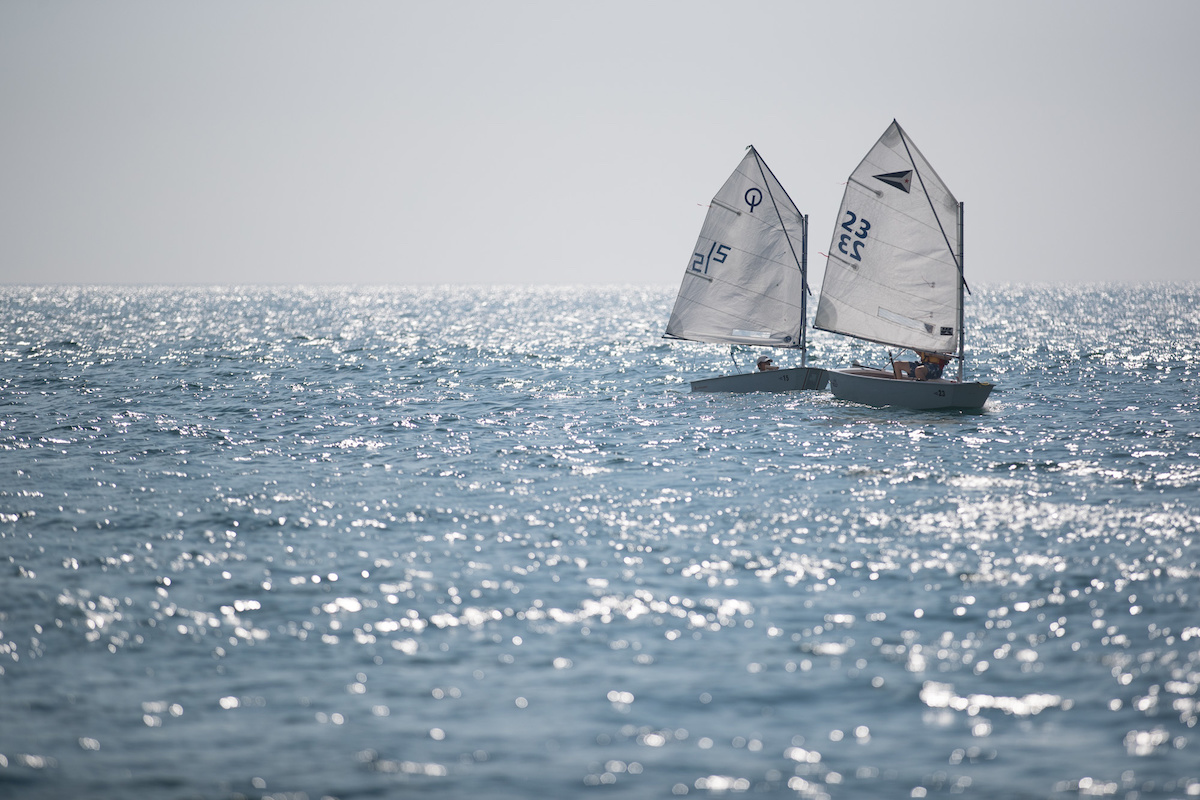
Join Our Newsletter!
Get community news, buying bargains, and how-to guides at your fingertips.

Motor Boat Types Explained: How to Find the Right One for You
- Latest Posts
Do you dream of owning a motorboat? Motorboats are great for fishing, water sports, adventure, and fun. They are also referred to as speedboats and powerboats and come in different shapes and sizes. There are different types of motorboats today. This article has all the different motor boat types explained as well as their advantages and disadvantages. Read on to find your dream motorboat.
Types of Motor Boats
Bowrider motor boats.
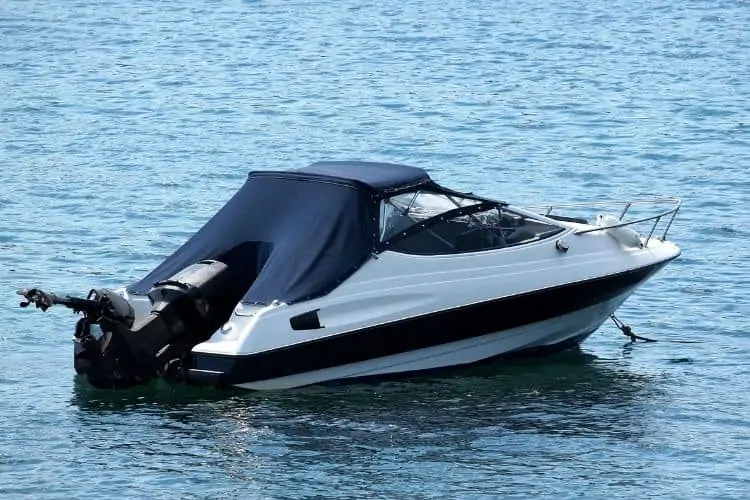
Bowriders are a perfect choice for beginners and those with family. The open bow area makes room for extra seats in the helm and can hold more than 8 passengers. The boat is about 17-30 inches in length. The V-shaped hull offers smooth rides, whether on inland waters or coastal waters.
The boat can be powered by outboard engines or stern drive and can be used for water sports or fishing.
- Bowriders can be used for water sports, entertaining, fishing, and entertainment.
- It can fit up to 9 passengers.
- It can be powered by a sterndrive, jet propulsion, inboard, or outboard engines.
- The motorboat looks crammed with maximum passengers on board.
Cabin Cruisers

Powerboats that have sleeping accommodations onboard are referred to as cabin cruisers. They are ideal for relaxed cruises as they include modern comforts like air conditioners, heaters, and power generators.
These cruiser boats have a deep V-bottom, shaft drive mechanism, and rudder steering. The cruiser is mainly used on salty, coastal waters and can be propelled with pod drive, sterndrive, outboard, and inboard motors.
- The motorboat is great for day and night cruising.
- It has a seating capacity of 10 people.
- The cruiser offers luxury and accommodation.
- They are expensive to buy and maintain.
Center Console Powerboats
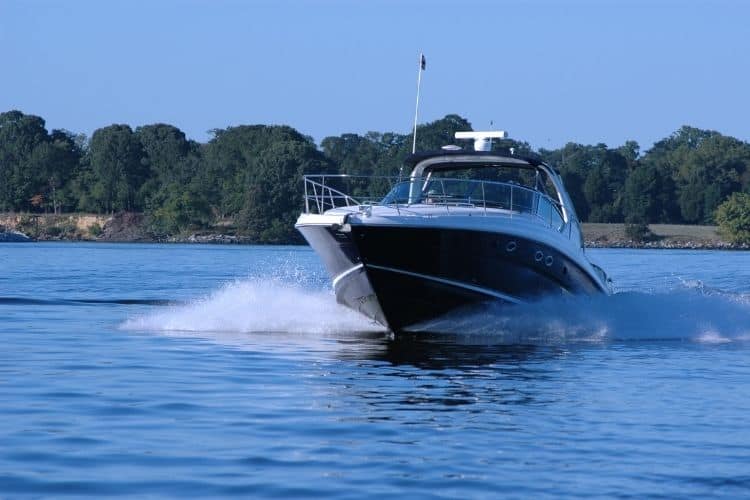
The center console gets its name from the fact that the helm is fitted in the console found at the boat’s center. It lacks a foredeck and cabin. The motor boat’s design makes it possible for anglers to walk from the bow to the stern without stepping on the gunwales. This 13-45’’ boat uses outboard motors to cruise.
Center consoles are great for sports fishing. They work perfectly in harsh offshore waterways where there are plenty of schools of fish. The deck in center consoles has powerful insulation to ice the fish storage. Also, the boat can hold fish lockers, outriggers, gunwale rod holders, and bait wells.
- Center consoles can be used for fresh and saltwater fishing, cruising, and water sports.
- They have better access to water.
- They are easy to maintain.
- It lacks protection from the elements.
Convertible Motor Boats
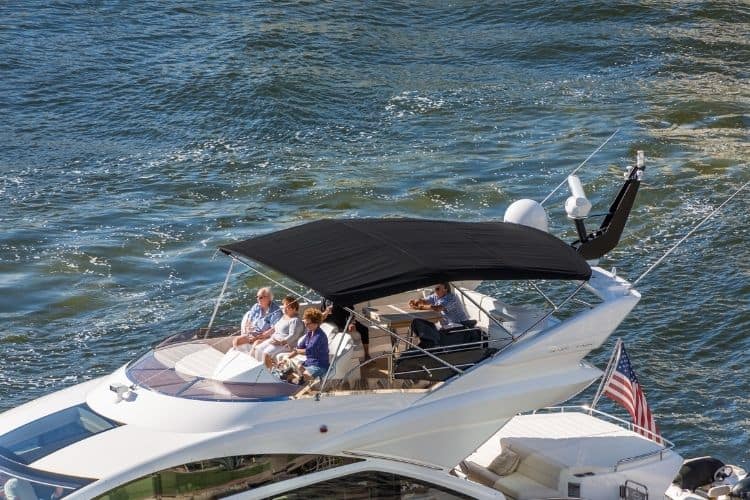
Convertible motor boats are great for fishing and weekend cruising. This large-sized boat has a large cabin, a flybridge for running the boat, an entertaining area for passengers, and an advantage point for spotting fish grounds.
- They have large cabins.
- The height of the flybridge elevates the captain to spot fish-grounds easily.
- They are ideal for offshore fishing.
- They are easily accessible, like express fishing boats.
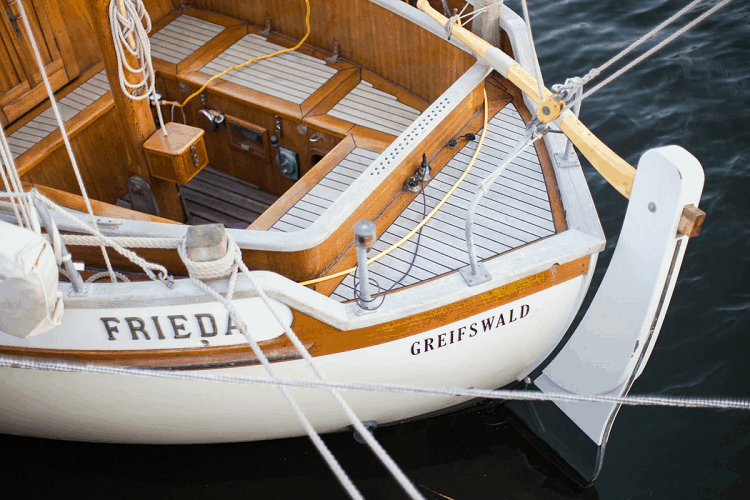
Deck boats are 25-35 ft. long and are mainly made of fiberglass or aluminum. They have better performance and space compared to pontoon boats since they have a V-shaped hull. The open deck available on the boat provides plenty of seating space for passengers. They, however, have no space for accommodation below the deck.
Deck boats are either powered by stern drive, jet drive, or outboard engines. The boat is mainly used for recreation activities such as water sports and swimming.
- They are perfect for families and parties.
- They have more capabilities and amenities than bowriders.
- They can hold up to 14 people.
- They are not fast.
- They are less spacious compared to pontoons.
Bowrider Boats

This boat is also called a quintessential family boat. They have spacious rooms for more than eight passengers on the cockpit, helm, and bow cockpit. These boats also offer comfort and leisure through the swim platform.
Bowriders have a V-shaped bottom that can cruise through different weather conditions. Although the bowrider offers splendid rides using the sterndrive power, the demand to use outboard engines is on demand.
- They are versatile and can be used for fishing, watersports, and entertaining.
- Bowriders are affordable.
- Passengers can sit in the front and back.
- They are easy to drive.
- It is not great for overnight cruising.
- It has narrow and cramped seating at the front.
Dinghy Boats
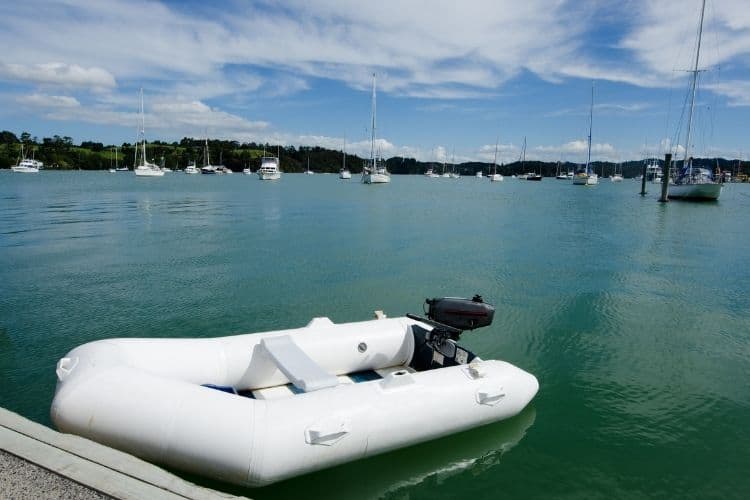
Dinghy boats can be hard-sided or inflatable. Although oars and sails powered them in the past, dinghy boars are now powered by small outboard motors.
They are often used for transporting passengers and their personal effects to and from shore when a mothership cannot get onshore. The motorboats are also used for camping expeditions and fishing.
- Inflatable dinghy boats are easy to store.
- They are extremely lightweight.
- They are stable and durable.
- Soft inflatable dinghy boats can flip you in water on impact.
Express Cruiser Boats
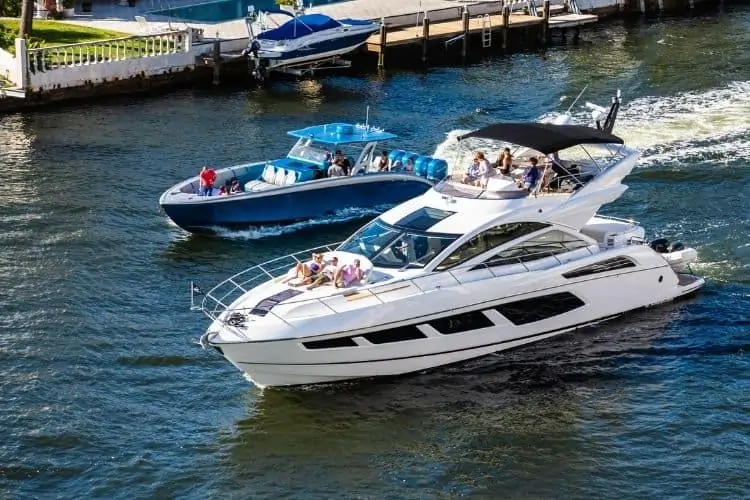
Express boats have large cockpits where guests get entertained both indoors and outdoors. The helm is slightly elevated and tucked up by the boat’s windscreen. Besides, these 30-50-foot-long cruisers have more outdoor space and multiple cabins.
In terms of cruising, these motorboats can achieve speeds of 25-30 knots. They can be powered by pod drives, stern drives, or twin engines.
- Express cruiser boats are great for sightseeing.
- They have more outdoor space.
- They have fast speeds.
- They consume a lot of fuel.
- They are pricey.
High-Performance Motor Boats
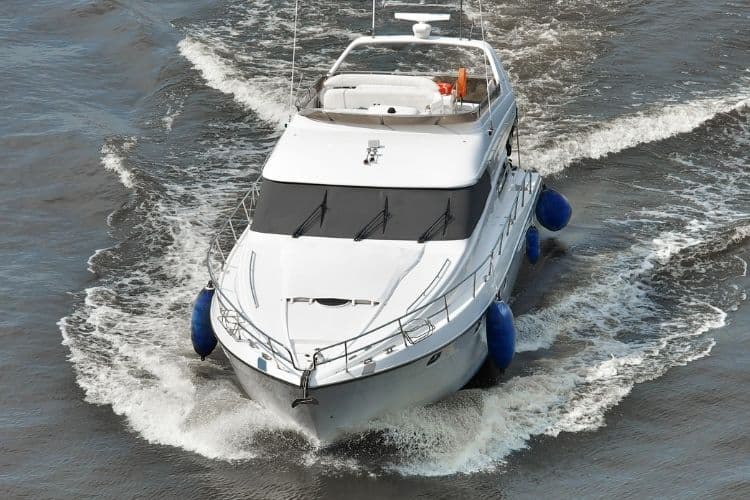
As the name suggests, these motorboats are designed for speed and performance. Their high power to weight ratio, steep deadrise, and narrow beam help the boat perform on the water. High-performance boats are also referred to as go-fast boats and muscle boats.
These go-fast motorboats are powered by stern drives, high horsepower outboards, or surface drives. With 25-60 ft. length, these boats are light, strong, fast, and ideal for fast cruising.
- They can hold up to 6 passengers in the cockpit.
- They are built for racing.
- They are expensive
Personal Watercraft Boat

Personal watercraft are designed for fun, pleasure, and adventure. These boats are also referred to as jet skis and water scooters. With them, one can explore the waters or engage in water sports. Personal watercraft are either sit-downs or stand-ups. Sit-down s can hold two or more passengers, while stand-ups can only hold one rider.
- They are smaller and easier to maneuver
- They are perfect for water sports and adventure.
- Servicing them is easy, and they are more stable on the water.
- You need safety gear when riding a personal watercraft powerboat.

Houseboats are also known as floating houses as they have dining areas, bedrooms, and kitchens. These boats are ideal for families, entertaining, recreation, cruising, or enjoying water sports. They come in different shapes and sizes and mostly measure 25 ft. in length to 150 ft.
Houseboats have broad flooring and modern amenities to offer luxury. These boats are motorized and are incapable of working on their power.
- Houseboats can also be used as living houses.
- You have vacation activities throughout the year.
- Fishing takes place anytime.
- If you live on a houseboat, you have to join the homeowner’s association.
Inflatable Boats
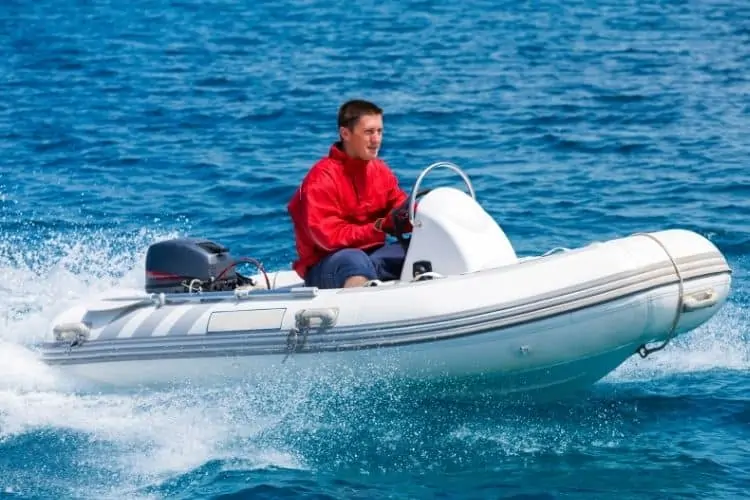
These boats have inflatable tubes on the sides for fast and easy inflation and deflation. They also have flexible or rigid floors, depending on their size. Measuring 6-14’’, inflatable boats are ideal for beginners.
The common motors used in inflatables are outboard motors as they can be mounted on the rigid transom.
- They are lightweight when deflated, making them easy to transport.
- They are good for beginners.
- They are not as stable as other powerboats.
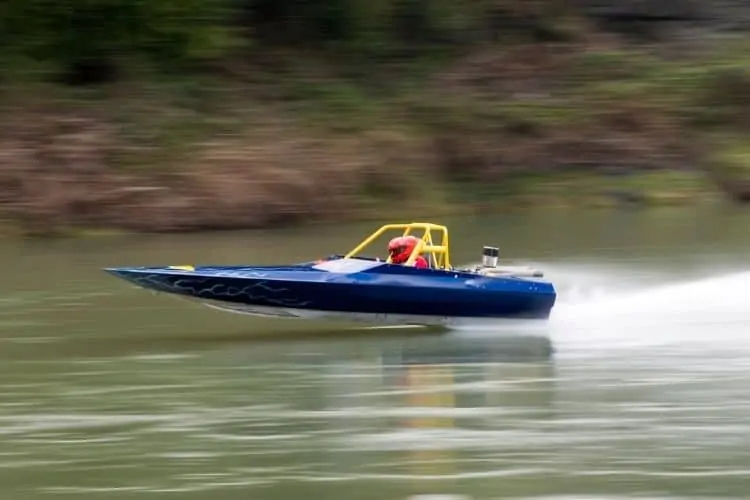
These are run by single or several jet drives. They are mostly used in shallow waters and water sports because of their small size. Jet boats are highly maneuverable too.
- It has quick turning capability and acceleration.
- They can achieve top speeds.
- They lack an exterior propeller.
Pilothouse Boats
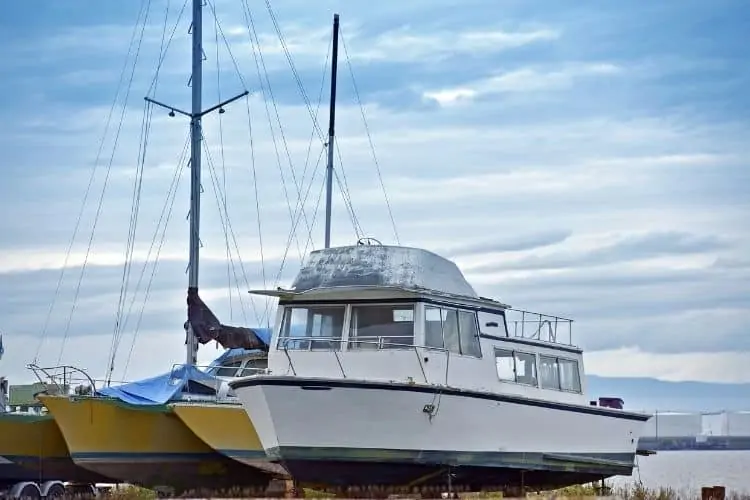
Designed to ride rougher seas, the pilothouse boats are fully enclosed to keep the helmsman dry. They are great for cruising and fishing. These boats have a berth and head and are 20-35 ft. in length.
The pilothouse boats can be powered by inboards, outboards, and stern drives.
- The helmsman stays high and dry even in rough sea conditions.
- It has reduced wind and engine noise.
- Mounting accessories on a pilothouse motorboat is easy.
- It can be hot and stuffy if the boat does not have an air-conditioner.
Pontoon Boats
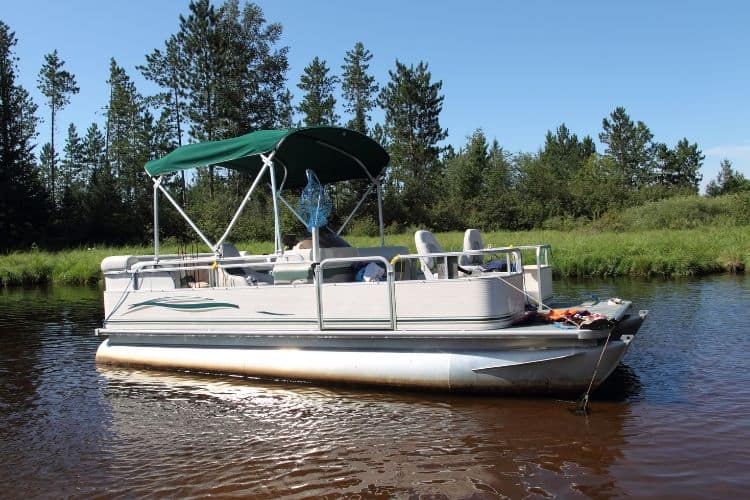
Mainly used in small water bodies, rivers, and inland lakes, pontoon boats are ideal for water sports, fishing, and cruising. They are available in 15-30 ft. length, have shallow drafts, and are highly stable. They also support a broad platform with the multiple aluminum pontoons fitted. These boats have flat decks and a fence for tour groups.
Sterndrives or outboard motors often power pontoon boats.
- They are comfortable and have great speeds.
- They can be used for fishing and water sports.
- They offer safety.
- They are not ideal for rough waters.
Power Catamaran

Power catamarans are dual hull boats that offshore fishers mainly use. Not only are they rugged, but they also offer stable rides. Furthermore, they can achieve fast speeds and consume less fuel compared to mono-hulls. They also have higher displacement, less hull volume, and shallow drafts.
Power catamaran boats have lengths of 25-40 ft. They are excellent for leisure and fishing. These boats use sails and engines, making them a crossover powerboat.
- They have more space than monohulls.
- They are more stable on waves.
- Dual hulls are faster than monohulls.
- They are more expensive than yachts.
Cuddy Cabins
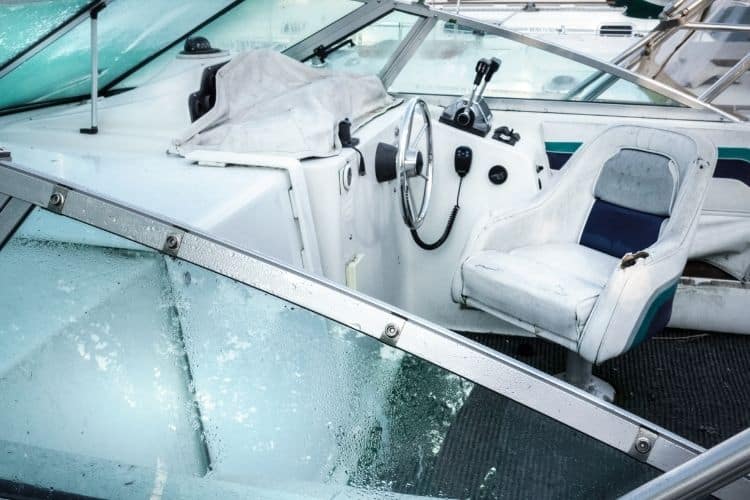
Cuddy cabin is a family-friendly powerboat. It can be used for sailing, fishing, leisure, and yachting. With a closed deck on the boat’s bow, the cuddy cabin is easy to navigate and has ample storage space. In terms of materials used, these boats are usually made of aluminum and fiberglass with a length of not less than 475 meters.
- They provide a dynamic cruising experience.
- They are trailer-able and can cruise different waters.
- They have sleeping space for day naps and nights.
- Bow access is limited.
Runabout Motor Boats
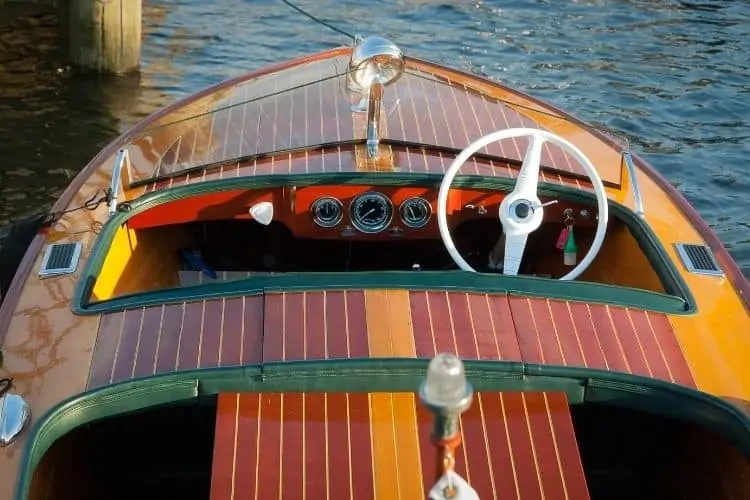
Small motorboats between 14-24 ft. in length are known as runabouts. They can be used for water sports, cruising, or fishing; runabouts can be powered by a sterndrive engine or an outboard motor. The open boat has a steering wheel behind a windscreen as well as forward controls.
Runabout motorboats can accommodate up to eight people.
- They are inexpensive.
- They are low-maintenance.
- Runabout speedboats are versatile.
- They have limited fuel capacity, thus limiting the travel range.
Utility Boats

Designed for tough use, utility boats are mainly powered by outboard motors. They are generally made of aluminum or fiberglass and are 12-20 ft. The boats can either be used as workboats or fishing vessels.
- They are ideal for novice boaters
- They are inexpensive to maintain.
- Aluminum utility boats are noisy at high speeds.
Walkarounds

These boats have side decks to provide room for anglers to move up the foredeck and around the cabin. Found in large water bodies, walkarounds measure 20-30 ft. in length. Walkarounds can use inboard engines, outboard motors, or both.
- There is plenty of room to walk around.
- They are fuel-efficient.
- They are heavy to trail around.
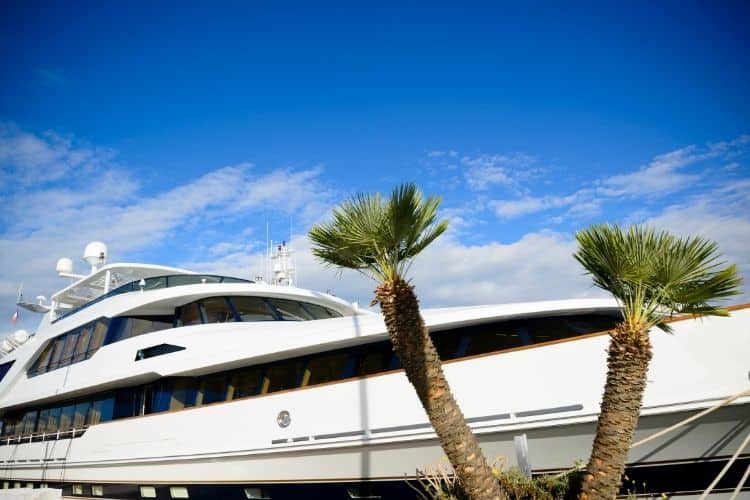
Yachts between 100-200 ft. long are known as superyachts. These motorboats have multiple decks, accommodations, a galley, lounges, and a living room. These boats are mainly used to host and entertain guests.
- It can cruise deep waters.
- They have recreational recreation.
- They are costly to maintain.

Any yacht with over 200 ft. length and up to 500 ft. height is referred to as a mega yacht. Most are custom-made and owned by the wealthy class. They feature state-of-art luxuries like a helipad, large swimming pools, plenty of guest rooms, and a crew of not less than 25 people. Ideally, they can be referred to as luxurious floating resorts.
- They offer affordable recreation and quality time for passengers.
- They can cruise in deep waters.
- Mega Yachts are only usable in warm seasons.
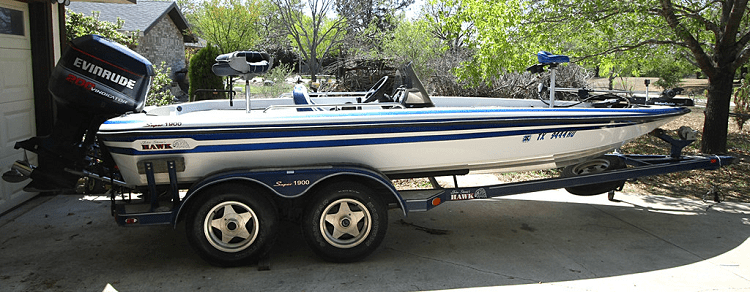
Bass boats measure 14-23 inches and are mainly used for freshwater fishing in rivers and inland lakes. Their design features a V-hull, flat deck, shallow draft, and low freeboard. They are fitted with special gear, trolling motors, and high horsepower outboards.
- They make good fishing vessels since the trolling motor operates quietly.
- They offer the freedom to fish in different waters.
- They have great casting platforms.
- They are slow.
- They have limited seating.
Although they have a low profile, bay boats are great for shallow waters near the shore or coastal waters. Their length measures 18-24 inches. They are made of fiberglass, which makes them durable when used in brackish and saltwater. Compared with flatboats, bay boats have more free boards.
- The low-slung gunwales make it easy to swing fish into the boat.
- They are great for fishing in very shallow waters.
- They come with basic fishing features.
- They can only hold three people.
Sedan Bridge
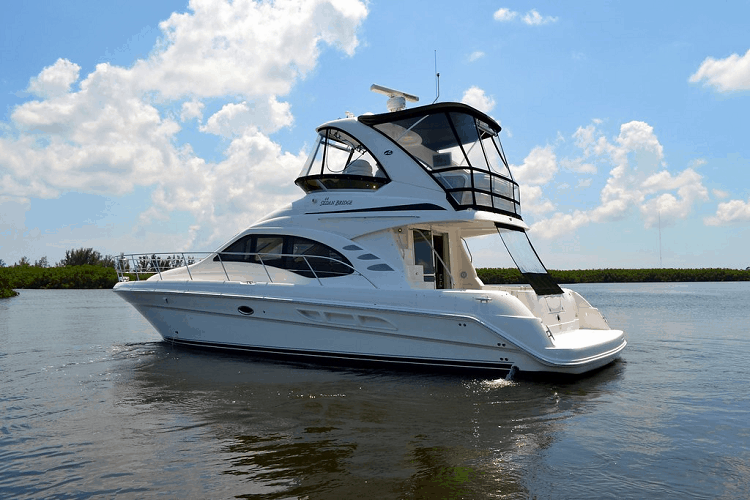
A sedan bridge is typically 35-65 feet long and offers the captain or navigator excellent visibility. What’s more, the cockpit level in a Sedan bridge is close to that of the boat’s aft deck. For this reason, this powerboat does not need a ladder or stairs. Access to the cockpit is relatively easy on the Sedan Bridge.
- It has plenty of room in the salon.
- They are easier to operate, clean, and wax.
- Not perfect for rough waters.
Other types of powerboats include;
With a pointed bow and flat bottom, skiffs are perfect for navigating shallow waters. They come in different lengths and sizes. It is easy to operate a skiff using a basic steering console.
Game boats are useful in game fish pursuits such as tuna and marlin and use diesel or petrol engines. These boats are large in size and made of fiberglass. They are also equipped with cooking galleys, plumbing systems, and sleeping berths.
Motor Yacht Boats
These are primarily leisure boats. The standard length of one is 12m and above and can hold 1-2 diesel engines. They are great for both short and long family trips.
Wakeboards/ Ski Boats
Although they look alike, wakeboards and ski boats have variations in terms of actions. Inboard ski boats need powerful acceleration. The shape of the propeller and engine also brings out noticeable differences.
On the other hand, inboard wakeboards have a V-drive engine system, huge wake, and deep hulls to get the boat in motion.
Factors to Consider When Choosing a Motor Boat
With over 30 motorboats to choose from, how can you find the perfect type for you? Below are factors you need to keep in mind before making the decision.
New or Preowned Motor Boat?
This should be one of the factors to consider when thinking about buying a boat. New boats are the best choice if you have saved for the purchase or money is not a problem. One advantage of buying a new boat is they have a warranty, so the repairs are covered in case of a malfunction.
What if you do not have enough money to get a new motorboat? Get a pre-owned one. However, ensure that it is thoroughly checked by a motorboat professional.
Reason and Frequency of Using the Motor Boat
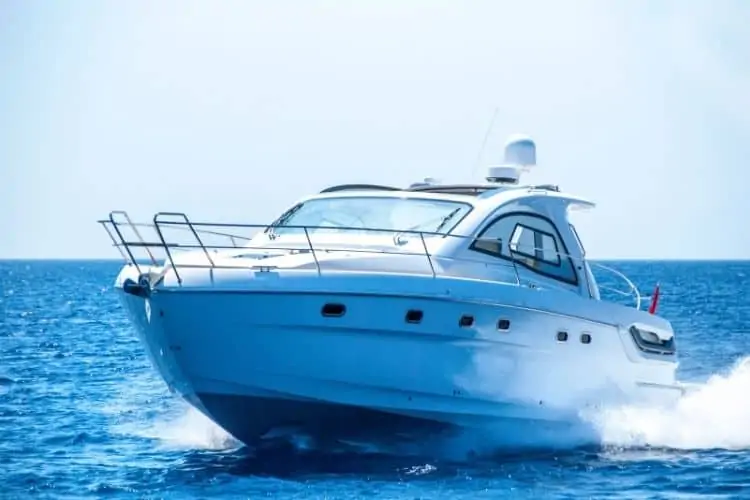
When choosing a motorboat, understand the reason why you need the boat. Is it for fishing? Will it be one of your entertainment assets? Or will it serve as a sailing boat or for family trips? Once you discern why you need the boat, you will make the right choice when choosing the motorboat.
After knowing what the boat will be used for, determine how often you will need it. Why? If the boat is for fishing, you need to understand how long the fishing seasons in your area last. What if the boat is for family trips? You need to tell when the weather is great for outdoor sports and when schools take a break so you can take the kids for a vacation.
Motorboats depreciate fast in the first year of purchase. If you discover that you will only take the boat on the water once every few months, the best decision is to wait. By doing so, you will save yourself the agony of depreciation and maintenance fees.
Thinking about the reason and frequency of using the boat beforehand will help you maximize your investment.
Motor Boat Use
If you are getting confused looking at different motorboats, here are a few questions to reflect on and help you make the decision.
- Are you looking to impress guests and business associates?
- Do you want a motorboat that fits on a trailer?
- Are you looking for a boat that can hold your family?
- Is the boat for water sports?
- Do you have experience in motorboating?
- Are you looking for a multi-purpose boat?
- Do you need help operating the powerboat?
- How much boat loan payment can you afford monthly?
Finding answers to the above questions will help you minimize your options.
Your Location
Before buying a speedboat, consider whether you have access to a water body. If you do have access to a body of water, confirm whether the waterways are appropriate with the use and type of boat you want. For example, if you buy a motorboat for fishing and live close to a lake, check whether fishing is allowed on the lake.
The location also plays an important role in terms of storage. Are there slip options and marinas in your area? Are boats allowed on the streets by the homeowner’s association? Considering these options before purchase will help you find the best storage options when you buy the motorboat.
Type of Motor Boat
As previously stated, there are plenty of types of motorboats. Nevertheless, they all will not match your user needs. For starters, consider the size of the boat. How many people are you planning to have onboard?
Do you need space for fishing gear? Does your boat require sleeping accommodations? These factors will determine the size of the powerboat you need.
Besides, take into consideration the condition of the motorboat. For pre-owned motorboats, consider whether they will meet both your short and long-term goals. Moreover, calculate how much you will spend on maintenance as old boats need more repairs.
Type of Hull
There are three main types of powerboat hulls; displacement hulls, planing hulls, and semi-displacement hulls.
Displacement hulls are found in heavy vessels such as tugs and trawlers. They are fuel-efficient and can navigate through rough seas. Unfortunately, they are not fast, making them ideal for long distances.
Planing hulls, on the other hand, skim over the water at high speeds. Made of lightweight materials, planing hulls are powered by powerful engines. They, however, have high costs of maintenance and fuel consumption.
Semi-displacement hulls offer both speed and functionality. Although they are not as fast as planing hulls, they achieve reasonable speeds and cruise through rugged seas. Many boat builders and designers prefer semi-displacement motorboats.
Storage also plays a role when choosing the type of speedboat. Some motorboats can fit on trailers and others in a storage unit area. Keep in mind that the bigger the boat, the larger the storage space, trailer, and towing truck. Huge boats may force you to get permits and hire professionals when moving.
Also, pay attention to storage costs during winter or when you are not using the motorboat.
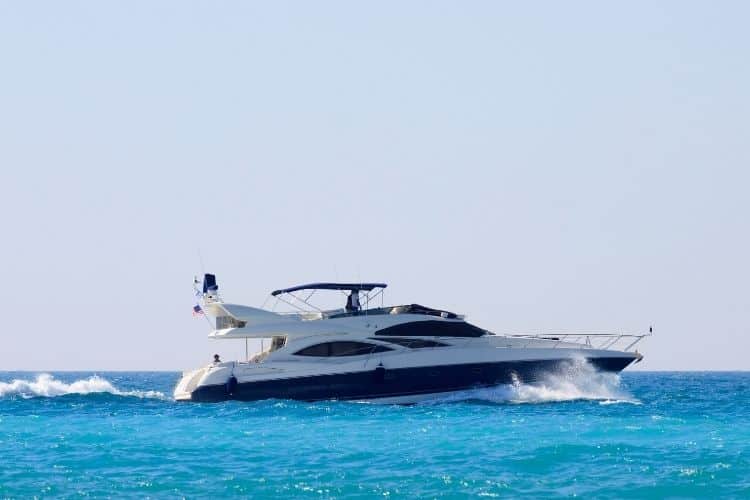
How much will the motorboat cost you? By cost, consider the upfront cost of buying the boat, maintenance, storage fees, gear, fuel, accessories, trailers, and hitches. Besides, you need to set money aside for boat insurance.
Boat insurance covers physical damage on the motorboat, loss, and damage of personal effects on the boat and injuries in the event of a boating collision. Talk to your insurer before purchase to get a quote on expected insurance costs.
On the other hand, if you are not looking to pay upfront, you can look into historic lows. Today, there are plenty of marine lenders who can finance your boat loan for 10 to 20 years. Before choosing a marine lender, determine carefully whether your cash flow can sustain that long-term loan.
Legal System
Different states have different regulations. For example, some states require boat operators to own an operator’s card to prove their competence. Therefore, check what the laws require of you as a boat owner before the purchase.
The same applies to buying a pre-owned motor; ensure the seller transfers the motor boat’s ownership under your name. What if the seller cannot find proof of ownership? Ensure you get a declaration under oath from them about why they do not have proof of ownership.
You must have browsed through different boat brands when looking for a motorboat. Good thing, most motorboat brands have boat owners clubs where you can get crucial information about boats. Here, you can ask questions and tips about the brand before the purchase.
Besides, it is much cheaper to make an online purchase. However, if you have not made the final decision yet, attend a boat show to view and access the different models and brands available. Talk to experts and ask their opinions based on your intent on the motorboat.
You must ensure that a motorboat is seaworthy, especially pre-owned boats. Walk around the boat and access the vessel. Next, take the motorboat for a sea trial and gauge whether there are any problems.
If you are inexperienced in boating, a shiny, clean motorboat may blind you. Therefore, hire a professional marine surveyor as you may miss some important issues. Once you are done with the sea trial, haul the motorboat out of water for the surveyor to inspect the parts under the waterline. Inspecting the powerboat before the purchase will save you from making a wrong financial investment.
Whether buying a new or used boat, find out what else is included in the purchase. Have the seller provide you with a list of equipment included in the sale. You can then choose to take the whole package or shop the amenities on your own.
Question: Can I purchase a boat without qualifications?
Answer: Yes. Owning a private motorboat does not necessarily mean you need qualifications. However, there are advantages to having one.
Question: Which are the best motor boats for beginners?
Answer: Dinghies, bowriders, and pontoon boats are some of the best motor boats for beginners. They have simple propulsion systems and are more flexible.
Question: Should I buy a new or pre-owned motorboat?
Answer: Buying a new motorboat is the wisest decision because you get exactly what you are looking for. Sadly, new motorboats are expensive compared to pre-owned boats. Buying a used boat will save you money, and if not inspected thoroughly, you may find yourself with a lemon.
Question: What do I need to know about motorboat coverage?
Answer: Some small motorboats are covered on a homeowner’s policy, while large motorboats require a separate insurance policy. Also, boat insurance offers limited coverage on your personal effects.
Since there are numerous types of motorboats in the market, you find the ideal choice for you. Pick that motorboat that fits your needs, family, speed, and budget.
Personal watercraft are perfect for 1-2 riders, while cuddy cabins are family-friendly. In terms of entertaining guests, express cruiser boats, superyachts, and Megayachts are the real deal.
Take your time going through the different types of powerboats, ask expert opinions, and make an informed investment for your money.
- 2024 BOAT BUYERS GUIDE
- Email Newsletters
- Boat of the Year
- 2024 Freshwater Boat and Gear Buyers Guide
- 2024 Boat Buyers Guide
- 2024 Water Sports Boat Buyers Guide
- 2023 Pontoon Boat Buyers Guide
- Cruising Boats
- Pontoon Boats
- Fishing Boats
- Personal Watercraft
- Water Sports
- Boat Walkthroughs
- What To Look For
- Best Marine Electronics & Technology
- Watersports Favorites Spring 2022
- Boating Lab
- Boating Safety

Best Personal Watercraft to Consider in 2024
- By Jeff Hemmel
- January 13, 2024
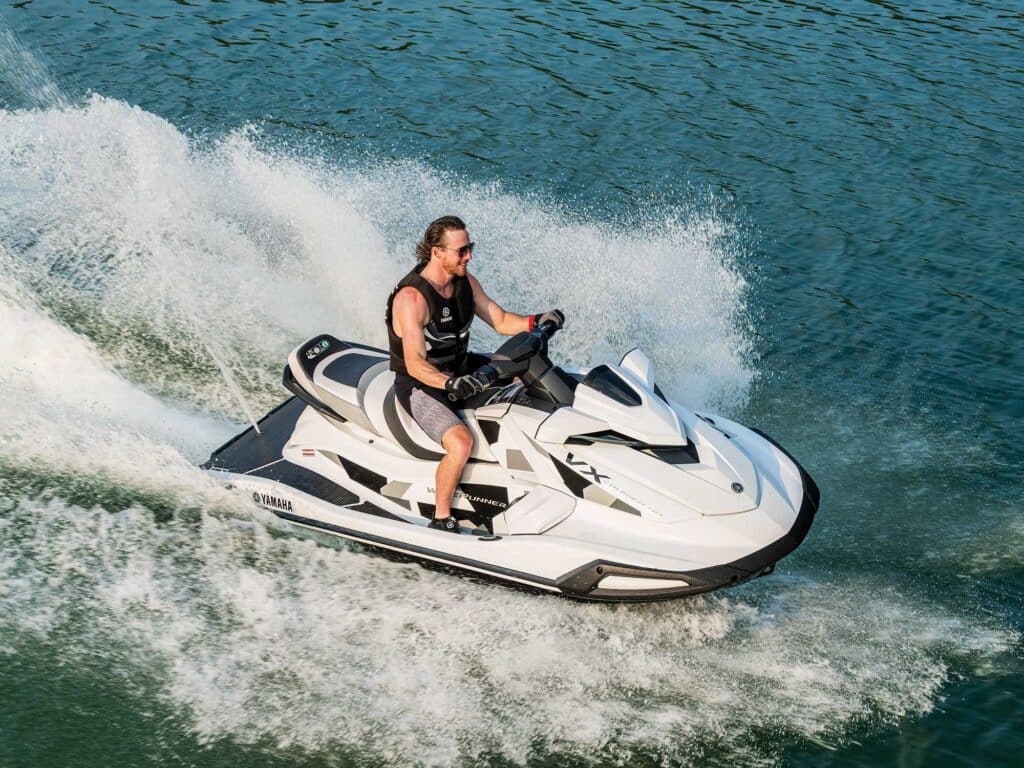
Originally conceived as a “motorcycle or snowmobile for the water,” today’s personal watercraft have matured far beyond simple thrill rides to reflect the diverse interests of the modern buyer.
Yes, performance on the high-end is more of a thrill than ever. Sea-Doo, Yamaha and Kawasaki (the owner of the commonly used term Jet Ski) all produce models that boast impressive acceleration, run in the 65 mph range and corner with ferocity. Those same manufacturers, however, also produce recreational models aimed at first-time buyers, midrange models that combine thrills with fuel efficiency, and specialty craft that target everyone from the fishing to watersports crowd.
Boating Magazine editors have performed on-water testing of nearly every model over the last two decades. Our insight and expert tips can help you narrow a sea of choices to find the ideal craft for you and your family. Here are some of our favorites, but keep in mind the market is quite large and numerous models may prove an ideal choice for individual buyers.
Article at a glance:
- Jet Ski Recommendations
- Buying Considerations & Tips
PWC Recommendations by Type
Just like the broader boating market, some personal watercraft are better suited to certain activities than others. Popular categories include recreational and touring craft, high-performance models and fish-and-family fun models.
Review the best jet skis by type:
Best jet skis for fishing.
Virtually any PWC can be used for casual fishing, but several recent models have taken aim at the more hardcore angler with amenities including rodholders, coolers, and GPS/Fishfinders. Sea-Doo’s Fish Pro series tops the list. Yamaha, meanwhile, offers several fishing-specific accessory packages. Find a more extensive list of the best PWC for fishing in our recent article .
Sea-Doo Fish Pro Trophy
The ultimate fishing-ready PWC, with amenities to satisfy the most serious angler.
Sea-Doo is currently the only manufacturer producing a dedicated fishing line, and the Fish Pro Trophy is the flagship of the trio. Based on the GTX hull platform, the Trophy is exceptionally stable, both underway and at rest. The latter trait makes it possible to stand and cast or battle even the most spirited catch without worries of going overboard. Fishing amenities include a 13.5-gallon cooler plumbed to double as a livewell, 7” Garmin touchscreen GPS/Fishfinder, raw-water washdown and an innovative saddle design that allows the rear portion of the seat to convert into a raised, pedestal fishing chair. Additional features include a debris-flushing pump system ideal for skinny, weed-prone waters, low-speed trolling modes added to the craft’s speed control, heavy-duty batteries with 650-watt voltage generator and quick-release anchor. Power is provided by a naturally aspirated, 170hp Rotax engine that proves quite powerful yet fuel-efficient for increased range.
Pricing and Specs
What we like:
- Long list of standard features, ready to satisfy the most hardcore angler.
- Excellent stability, particularly at rest.
- Naturally aspirated engine improves fuel efficiency, extends range.
What could be better:
- Significant weight aft, particularly with a loaded cooler, can affect handling.
Yamaha FX HO w/RecDeck
Choice of optional fishing packages increase versatility of standout performer.
Rather than a dedicated fishing model, Yamaha builds upon a foundation of the flagship FX-series hull and 1.9-liter, naturally aspirated engine. Together, it’s a package ready for anything from calm lakes to rough, offshore conditions and offers exceptional stability underway or at rest. Buyers can choose how “fishy” to make their FX. We suggest starting with the RecDeck, a broad platform that mounts atop the existing swim platform to greatly increase deck space aft and serve as the mounting point for one of two optional fishing packages. The Premium JetFish package adds a multi-use rack atop the platform that secures a cooler and includes a pair of both rod and cup holders. Additional eyelets and tiedowns secure other gear. A choice of Garmin GPS/Fishfinders can also be added to the console, including a 6” EchoMap.
- RecDeck includes pull-out boarding ladder, options beyond fishing, including rear-facing lounge seat.
- FX hull tracks straight and true in rough water.
- Cooler only; livewell option would add versatility.
- RecDeck and accessories add considerable weight aft, affecting handling.
– ALWAYS USE YOUR ENGINE CUT-OFF LANYARD – Make sure your Engine Cut-Off Switch lanyard is attached to your person. They’re required on all personal watercraft and boats under 26 feet. Safety Tip Provided by the U.S. Coast Guard
Best Recreational & Touring Personal Watercraft
One of the most versatile segments of the PWC market, recreational and touring models typically offer stable, three-passenger hull designs and forego gas-hungry supercharged engines in favor of naturally aspirated alternatives that increase range and stretch a fuel budget. Plenty of power is still on hand to satisfy the performance-minded solo rider or pull watersports lovers on tube or board, but comfort is equally important. Expect cushy, supportive saddles and modern electronic enhancements like cruise control and available sound systems.
Kawasaki Ultra 160LX-S
Midrange model combines latest flagship amenities with touring-friendly, fuel-efficient engine.
Kawasaki plays the morphing game with the Ultra 160LX-S, combining the flagship style and high-tech features offered on the flagship Ultra 310 LX with a more touring-friendly, non-supercharged version of its 1,498cc engine that promises to run far longer between fuel stops. Highlights include a tiered saddle to keep both driver and passengers comfortable on extended cruises, an intuitive electronic reverse and deceleration system, 7” color information display and 200-watt, four-speaker sound system. Unique? A rearview camera that comes in handy not only when backing up in tight confines, but also monitoring overtaking traffic when running in open water.
- Proven hull design offers a stable, predictable ride in all water conditions.
- Cruise control, no-wake mode, auto-trim, stylish LED accent lights.
- Aft platform track system can secure cooler, gas caddy or other accessories.
- Slight lag when transitioning between forward, neutral and reverse.
- Gullwing storage solution is unique and keeps items close at hand, but can be slightly awkward to reach around handlebars.
Sea-Doo GTX
Comfortable, cushy cruiser offers power, handling…and innovative storage and cargo options.
The GTX hits the recreational/touring sweet spot with its combination of the flagship GTX hull design and more fuel-efficient, touring-friendly version of the Rotax 1630 ACE engine rated at 170hp. Touring riders will love the tiered, three-passenger saddle with its pronounced bolsters offering lower-back support. Cruise control and no-wake modes lock in speeds to alleviate throttle fatigue. An extended aft deck, equipped with pop-up LinQ accessory mounts, is ready for extra gear including cooler, storage bag or fuel caddies.
- Innovative bow storage opens directly in front of the driver, offering access to the contents without leaving the saddle or stretching over the handlebars.
- Intelligent Debris Free pump system spins driveshaft in reverse to flush away debris and weeds.
- Electronic reverse and braking system provides intuitive low-speed handling, powerful deceleration at speed.
- LinQ accessories integrate seamlessly, but can be somewhat pricey add-ons.
- Front storage more convenient, but smaller than competitive models.
Yamaha VX Cruiser HO
One of the best-selling platforms in market history, with cruiser-specific saddle and the largest displacement engine on the market.
Yamaha’s VX has dominated sales charts for over a decade thanks to a stable yet agile hull design, reliable engine and affordable price tag. The current model gets a boost in horsepower from a new 1.9-liter engine, the largest displacement seen yet in the PWC market. It gives the VX Cruiser HO impressive power without the fuel-hungry needs of a supercharger. Elsewhere, find a 4.3” color display with touchpad controls, user-selected top speed and acceleration settings, and Yamaha’s dual-throttle RiDE system which provides intuitive low-speed control of forward/neutral/reverse motion and rapid deceleration at speed. A Cruiser saddle positions each rider higher than the one in front, and offers generous back support.
- Connext LCD display includes Ride Control speed/acceleration profiles, security mode.
- Cruise control, no-wake mode, intuitive RiDE dual throttle system, optional Bluetooth audio system.
- Watertight glovebox w/USB/12-volt charging port, LED lighting.
- Connext display provides access to impressive amount of information/control, but not always the most intuitive to navigate.
– RIDE DEFENSIVELY – Personal watercraft are the motorcycles of the sea. Never assume other boaters can see you, so avoid high-traffic areas when you can and always ride defensively. Safety Tip Provided by the U.S. Coast Guard
Best Jet Skis for High-Performance
The “Top Guns” of the PWC world, these craft offer supercharged engines that accelerate at lightning speed, easily hit the 65 mph mark and, thanks to deep-V hull designs and aggressive sponsons, handle with slot-car-like precision. Look for ergonomic touches that keep a rider planted and in control, like sculpted, bolstered seats, adjustable handlebars and plenty of footwell traction. Extras can include automatic trim systems, selectable power curves and optional Bluetooth sound systems to cue up your favorite soundtrack.
Yamaha GP SVHO
A race-proven craft that excels in a variety of water conditions, and offers some of the most aggressive handling on the market.
GP models have earned a reputation amongst PWC performance enthusiasts for decades, and the current GP SVHO continues to live up to the hype. Powered by Yamaha’s 1.8-liter Super Vortex High Output engine, it provides the GP with more power and torque than any WaveRunner in the brand’s history. Drop that engine into a hull with both lightning-fast reflexes and rough-water credentials, and you’ve got a pro-ready race machine right out of the box. While performance reigns supreme, the GP is not without bells and whistles. Yamaha’s dual-throttle RiDE system offers intuitive forward/neutral/reverse low-speed maneuvering in tight confines, as well as rapid deceleration when desired at speed. A 4.3” color touchscreen display keeps tabs on vitals, as well as allows adjustment of top speed and acceleration profiles.
- Cruise Assist/No-Wake modes are welcome extras for longer-distance rides.
- Deep, wide footwells and sculpted saddle put riders in aggressive, yet comfortable position. Adjustable handlebar tilt further dials in fit.
- Optional 100-watt Bluetooth sound system integrates two 4.5” speakers into the design, operated by convenient touchpad.
- Not a negative as much as a reminder. Skis like the GP are targeted at skilled, experienced riders and not meant for beginner/intermediate riders.
- Though improved, ergonomics and turning style still put a lot of force on a rider’s upper body. Hit the gym.
Sea-Doo RXP-X 325
The newest horsepower king, offering an industry-topping 325 horsepower and multiple ergonomic touches.
Sea-Doo’s RXP-X 325 has long been defined by its incredibly tight-turning hull and ergonomic tweaks that allow riders to transfer much of the strain of those turns from the upper body to the stronger legs and trunk. But for 2024, it’s probably best known by its new 325hp Rotax engine that produces the highest horsepower ever seen in the PWC market. You can definitely feel it. Pin the throttle, hold on tight and the 60 mph threshold passes by in as little as 3.4 seconds. The increased power only adds to the RXP-X’s turning ability. An adjustable backrest adds to the craft’s ErgoLock features to keep the pilot in control. Riders can now also dial in the feel of the handlebars via an adjustable steering damper that eliminates play and stiffens response to reduce unwanted feedback, especially in rough conditions.
- Intelligent Brake & Reverse provides rapid deceleration at speed, but also shines at low-speed with intuitive control of forward, neutral and reverse.
- Launch Control automates trim position during acceleration, providing the optimal running angle for best performance.
- Optional Tech Package adds full-color 7.8” display, 100-watt Bluetooth audio system, smartphone app integration for music, weather and navigation.
- Not a negative as much as a reminder. Skis like the RXP-X are targeted at skilled, experienced riders and not meant for beginner/intermediate riders.
- App integration not always intuitive, can be glitchy.
Kawasaki Ultra 310X
Longtime offshore racing champ combines brutal power delivery with one of the most confident rides in rough water.
Kawasaki’s Ultra 310 line has built a reputation on impressive offshore racing performance, racking up countless racing titles over the years. But despite being the largest, heaviest craft in this lineup, the Ultra 310X is also no slouch in calm conditions, carving up the water with the precision and feel of a much smaller craft. The 310X makes full use of its 310 horsepower and Eaton twin-vortices supercharger, powering out of the hole and easily reaching 68+ mph. For such a beastly performance machine, the Ultra is also quite practical. Storage tops 40 gallons, with the large bow tub complemented by additional gullwing storage compartments to each side of the console for easy access from the driver’s seat. Other highlights include a vivid 7” color display with analog control knob and the long-awaited adoption of electronic reverse and deceleration, integrated into the craft’s righthand throttle.
- Deep-V hull is excellent in both rough inland waters and offshore conditions, tracking straight and true.
- Deeply bolstered saddle locks driver in during performance runs, provides tiered seating for passengers when cruising.
- Watertight phone compartment integrated into starboard side storage.
- Innovative side storage theoretically keeps items close at hand, but some may slide forward out of reach.
- Not a negative as much as a reminder. Skis like the Ultra 310X are targeted at skilled, experienced riders and not meant for beginner/intermediate riders.
– ALWAYS WEAR YOUR LIFE JACKET – Get a comfortable U.S. Coast Guard-approved life jacket designed for use on a PWC, and make sure you wear it every time. It’s the law, even for adults. Safety Tip Provided by the U.S. Coast Guard
Things to Consider When Buying a Jet Ski
Need more helping narrowing down your options? Here are five important issues to consider before buying your next PWC.
- How – and where – craft will be used: Take into consideration not only how you plan to use your craft and who with, but also the typical water conditions you’ll encounter.
- Important features: Touring riders will benefit from comfort and cargo options, performance riders trim systems, anglers rodholders and coolers.
- Storage: How you plan to use your craft will also dictate storage needs, but also consider ease of access, both on land and on water.
- Safety: Modern craft are all quite safe, but don’t get in over your head. High-performance models require skilled riders that can handle the horsepower and handling.
- Price: Like any other purchase, budget wisely. While flagship craft can run as high as $20,000, a $7,000 entry-level model can still offer plenty of fun.
Other FAQs about PWCs
Have more questions about personal watercraft? Check out our list of frequently asked questions below, as well as extensive reviews of many models in the pages of Boating Magazine and at boatingmag.com .
- What are the most important features to consider for a jet ski?
Safety, comfort and ease of use are important on any model, as well as the intuitiveness of controls like electronic reverse and deceleration systems. Beyond that, consider how you plan to use the craft and look for additional features — performance enhancements, fishing amenities, storage availability — tailored to your interests.
- How much do jet skis cost on average?
The lowest-priced PWC currently on the market is the Sea-Doo Spark at $6,999. The most expensive? Kawasaki’s flagship Ultra 310LX at $21,199. Midrange models typically hit the sweet spot, offering many of a flagship’s features without the cost of a supercharged engine.
- Do you need a boating license to drive personal watercraft?
Laws vary by state, so always check local regulations. The minimum age to operate a PWC is typically 12 – 18 years of age. Most states also require riders of a certain age to take a boating safety course and possess a valid certificate of completion.
- How to find laws for personal watercraft in your state?
The best resource for individual state laws and requirements has been compiled by the National Association of State Boating Law Adminstrators (NASBLA) and can be found at www.nasbla.org/nasblamain/nasbla-resources/statelawdashboards
- What are the best jet skis to consider for beginners?
Craft like Sea-Doo’s Spark and GTI, Yamaha’s EX and VX and Kawasaki’s STX 160 offer a great starting point for beginning riders, with stable hulls, enough horsepower to be fun but not overwhelm, and price tags that will leave enough money leftover for plenty of gas throughout the season.
- How long do jet skis normally last?
According to JD Power, personal watercraft engines have an average lifespan of 300 hours. Though that may not sound that long, consider that average yearly use is only 30 hours. As always, a PWC’s lifespan is impacted greatly by how well a craft is maintained.
- Can all jet skis be used in fresh and saltwater?
Yes, all personal watercraft can be used in both fresh and saltwater. Saltwater use, however, requires more care. Engines should be flushed with fresh water after use, easily done through provided flush fittings, to prevent deposits and eventual corrosion. Craft should also be rinsed on the exterior and added attention paid to the jet pump.
- Can jet skis pull skiers, tubes and board riders?
Three-passenger PWC can all pull watersports riders and often make an excellent, less-intimidating tow platform for teaching children. Without the confines of a boat, the spotter is easily seen and can offer assurance. Craft are also agile enough to quickly return to downed riders. Always use a spotter, and consider cruise control to keep speeds steady.
- More: coast guard , kawasaki , Personal Watercraft , Sea-Doo , Water Sports Foundation , Yamaha

Catching a Swordfish on a PWC
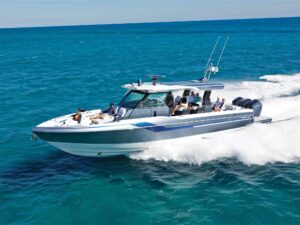
Boat Test: 2024 Formula 457 CCS
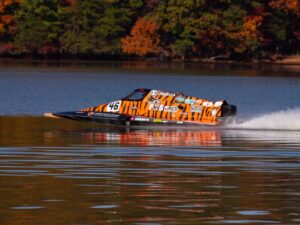
A New Electric-Powered-Boat Speed Record
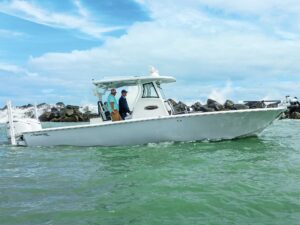
Boat Test: 2024 Tidewater 3100 Carolina Bay
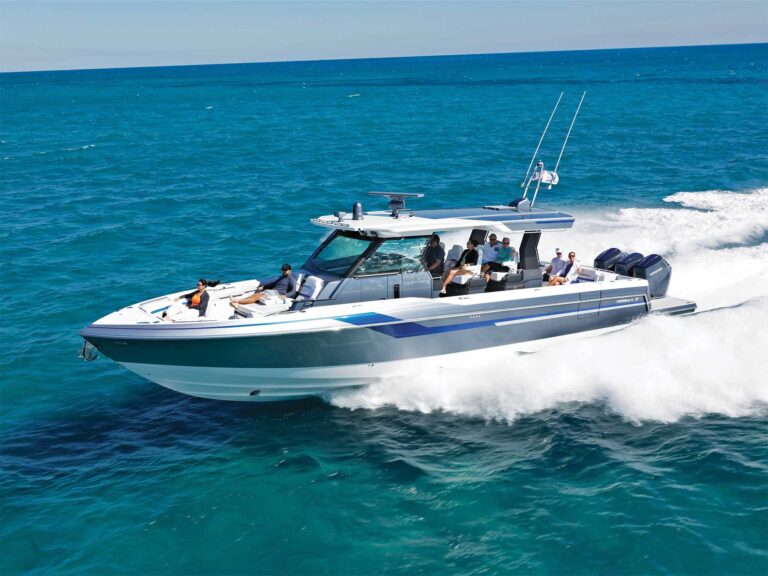
What to Do if Your Boat’s Engine Dies
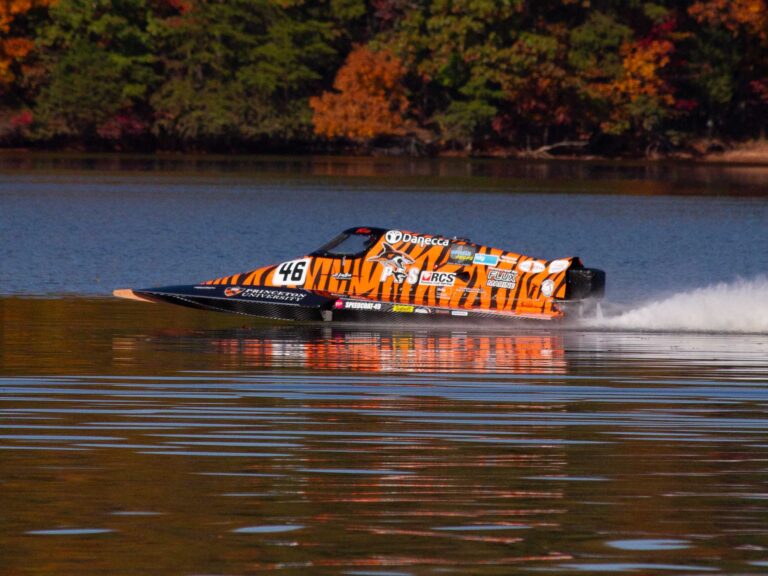
Six Tools for Spring Make-Ready

- Digital Edition
- Customer Service
- Privacy Policy
- Cruising World
- Sailing World
- Salt Water Sportsman
- Sport Fishing
- Wakeboarding
Many products featured on this site were editorially chosen. Boating may receive financial compensation for products purchased through this site.
Copyright © 2024 Boating Firecrown . All rights reserved. Reproduction in whole or in part without permission is prohibited.
- Boat Handling
- DIY / Projects
- Environment
- Knots to Know
- Marine Electronics

Operating your personal watercraft
Did you know that personal watercraft are recreational boats—just like your express cruiser, trawler or sailboat? As mechanically propelled vessels, they must follow the same navigation rules as other boats.
According to the U.S. Coast Guard’s 2019 Recreational Boating Statistics , personal watercraft are involved in 19 percent of reported boating accidents.
Like many cruising boats, PWCs typically have deep-V hulls. However, unlike propeller-driven vessels, personal watercraft have a water jet propulsion system. Without rudders, props, and struts to provide directional control or drag when slowing, a personal watercraft that loses power also loses nearly all steering and braking ability.
When a hazard suddenly appears, boaters instinctively back off on the throttle. Unfortunately, a PWC will continue in a straight path for some distance before stopping. This factor contributes to the disproportionately high accident rate of personal watercraft.
To improve the safety of PWCs, the industry responded by introducing off-throttle steering systems. Although they vary from manufacturer to manufacturer, these systems provide operators with some steering, even when not applying power.
To further improve safety, Sea-Doo introduced a braking system that uses a special propulsion nozzle to redirect some of the thrust forward to slow the vessel. In tests, watercaft with the system stopped in half the distance as those without it. Yamaha followed suit with its braking system.
The next time PWCs begin following in your wake, keep in mind that most can only be steered when under power, and few will be able to stop in a reasonable distance.
PWC characteristics
Personal watercraft are different from other boats. With their open, sit-on design, they are designed to run on plane, making them awkward at slow speeds, and are propelled by an internal water-jet that sucks water through a grate under the PWC and expels it under high pressure toward the rear, pushing the craft forward. They typically expel a small stream of water (which could be water that was used to cool the engine) straight upward to aid others in seeing the PWC.
How to operate your PWC safely
Personal watercraft operators must be alert and vigilant when operating a craft that goes so fast and responds so quickly. On a personal watercraft with no braking system, you must allow adequate distance to make a safe stop. The quickest way to stop may be to turn the PWC in a tight 180-degree arc under power.
You should expect to fall off your PWC. However, if you follow the manufacturer’s safety guidelines, your fall need not be dangerous as personal watercraft lack injury-causing rudders and propellers. If you fall, push yourself away from the personal watercraft.
Today, most PWCs come equipped with a lanyard cut-off switch that stops the engine when the operator falls off. You attach the lanyard to your wrist or life jacket and insert the other end into the cut-off switch plug. When you fall off, the cord pulls out of the cut-off plug, turning off the PWC. Then you can swim to the craft and reboard.
Don’t assume that all personal watercraft operators know the rules of the road. Practice the general rule of responsibility that requires you to depart from the rules as needed to avoid an accident. –Pat Lemagie

Operating your PWC
Gain valuable skills to help you operate your personal watercraft like a pro so you can focus on having fun.
Related Posts


IMAGES
VIDEO
COMMENTS
Size. PWCs, like boats, are on the market in a variety of sizes. Sit-down personal watercraft can measure anywhere from 40 to 50 inches wide and 120 to 130 inches long. A stand-up personal watercraft has an average width of 25 to 30 inches and a standard length of 80 to 100 inches.
The Powerboat Basics Powerboats come in all shapes and sizes. The smallest recreational powerboats are craft such as rigid-hulled or inflatable dinghies and personal watercraft, while the largest recreational power craft include large motor yachts and even mega yachts.But before we get buried in the ins and outs of powerboat types, let's take a look at the basic pieces and parts that make up ...
Bowrider. A bowrider has an open bow area designed for extra seats forward of the helm. Bowriders are usually 17'-30'. They are powered by either stern drive or outboard engines. Considered a family boat and can be used for fishing and water sports. A good choice for those new to boating.
A personal watercraft (PWC) offers you plenty of power, performance, and loads of fun. The "jet ski" and "wave runner" gained popularity over the last 20-years, with mass adoptions for sports and recreational use. PWCs offer your crossover use for fishing and watersports, with dozens of custom configurations for use in saltwater and ...
Personal watercraft are subject to the same rules and requirements as any other powerboat plus additional requirements specific to PWCs. PWC Regulations. In addition to the general regulations in effect for motorboats PWC owners must also be aware that there are local laws and ordinances around the country that further restrict PWC operations ...
Best High-Performance: Sea-Doo RXP-X 325. Boasting 325 hp, Sea-Doo's RXP-X 325 is the current Top Gun in the personal watercraft market. Created by some substantial tweaking of the existing ...
How many PWC are there? The National Marine Manufacturers Association reports that 41,600 new PWCs were sold in the U.S. in 2010, with an average price of $11,123. The majority of all PWC sold today include new-technology 4-stroke engines. NMMA estimates that in 2010, there were approximately 1.3 million PWC in use in the U.S.
Motor Yachts/Power Cruisers - When you want a boat that puts you squarely in the lap of luxury, a motor yacht/cruiser is the way to go. Multi-Hull Powerboats - Some boaters believe that two hulls are better than one, and multi-hull powerboats are their top pick. Personal Watercrafts (PWCs) - Get a personal watercraft, and you'd better get ...
Personal Water Craft (PWC) have become a major force in boating, accounting for a significant portion of new boat sales annually. There are more than one MILLION PWCs in use today. That is a huge number of boats, and unfortunately there is an equal amount of misunderstanding to go along with them. Did you know that a PWC was even considered a boat?
Compact three-seat PWC like the Yamaha WaveRunner EX and VX models, Sea-Doo GTS and GTI and Kawasaki Jet Ski STX are offered with a 90 to 155 horsepower engine and are capable of a top speed of 45 to 50 MPH. Full-size and full-feature models like the Yamaha WaveRunner FX series, Sea-Doo GTX and Kawasaki Jet Ski Ultra models offer 180 to 300 ...
A Personal Watercraft (PWC) is a type of vessel that appeals to thrill-seekers who crave a boating experience that puts them close to the water. They are compact, nimble, and powered by a water jet, providing an experience akin to riding a motorcycle on water. The affordability and easy maintenance of PWCs make them an attractive choice for ...
This pump sucks up seawater and then propels it at very high speed out the back of the boat. A good example of a jet boat is a personal watercraft (PWC), though there are a handful of watersports and cruising boats that use them. An external nozzle and bucket assembly is used to direct the thrust, thereby steering the boat.
In general terms, a standard, three-man, entry-level personal watercraft tends to come with 130 to 150hp, weigh in the region of 350kg and cost about £8,000; the mid-range craft, with more sophisticated cruising features and increased power, push on towards £12,000; and the top-end cruisers and race skis often feature 250hp or more and cost in the region of £14,000 to £17,000.
Best uses: dive boat or work boat. Dinghy— These are small boats, sometimes less than 10 feet long. They can be powered "manually," by oars or even by a small outboard motor. Best uses: transportation to larger boat at anchor or as a "first boat" for children. Inflatable— Inflatable boats are made of coated fabric.
Personal Watercrafts (PWCs) Many people think of personal watercraft (PWCs) more like motorcycles of the water, which has led some to refer to them as waterbikes, or boatercycles. But despite their small size and limited passenger capacity, these are still boats in every sense of the word. They're also among the most exciting to drive, and ...
Small motorboats between 14-24 ft. in length are known as runabouts. They can be used for water sports, cruising, or fishing; runabouts can be powered by a sterndrive engine or an outboard motor. The open boat has a steering wheel behind a windscreen as well as forward controls. Runabout motorboats can accommodate up to eight people.
By Jeff Hemmel. January 13, 2024. The VX Cruiser HO is just one of many great PWC models available. Courtesy Yamaha. Originally conceived as a "motorcycle or snowmobile for the water," today's personal watercraft have matured far beyond simple thrill rides to reflect the diverse interests of the modern buyer. Yes, performance on the high ...
A watercraft on the Mekong River. A personal watercraft (PWC), also called jet ski, sea-doo, or water scooter, is a primarily recreational watercraft that is designed to hold only a small number of occupants, who sit or stand on top of the craft, not within the craft as in a boat.. PWCs have two style categories. The first and the most popular is a compact runabout, typically holding no more ...
The most common types of pleasure craft include: sport fishing boats, bow riders, deck boats, inboard ski/wakeboard boats, houseboats, pontoon boats, cabin cruisers, yachts, personal watercraft, sailboats and paddle craft. Note: If the boat carries goods or passengers for any type of profit, it's considered to be a commercial boat.
How to operate your PWC safely. Personal watercraft operators must be alert and vigilant when operating a craft that goes so fast and responds so quickly. On a personal watercraft with no braking system, you must allow adequate distance to make a safe stop. The quickest way to stop may be to turn the PWC in a tight 180-degree arc under power.
Personal watercraft are scooters you ride in the water. Depending upon the model, you stand on them or straddle them like a motorcycle. They are usually motor driven and steered by the user. You ...
March 13, 2020. If someone were to ask me how to choose the right personal watercraft, my answer would be simple: find the model with the highest horsepower-to-weight ratio and buy that one. Price wouldn't really be an issue because unlike boats or automobiles, shopping for a new PWC means you can afford the very best of what's available on ...
A jet ski, also known as a personal watercraft, is a small and agile watercraft that is ridden standing up or kneeling down. It is propelled by a jet of water and can reach high speeds, making it a popular choice for adrenaline junkies. ... Jetski Vs Motorboat Exercise 2: Choose the correct term to complete the sentence: _____ are typically ...